Adam Tooze's Blog, page 27
January 12, 2022
Chartbook #68 Putin’s Challenge to Western hegemony – the 2022 edition.
As NATO meets to discuss the tension on the Russian border to Ukraine, and the papers fill with denunciations of Putin’s aggression, I still find it useful to return to the framework I developed in Crashed for analyzing the intersection of geopolitics and economics and the rise of Russia as a challenger. This framework consists of three basic propositions.
The first is that though it is tempting to dismiss Putin’s regime as a hangover from another era, or the harbinger of a new wave of authoritarianism, it has the weight that it does and commands our attention because global growth and global integration have enabled the Kremlin to accumulate considerable power. The sophistication of Russian weaponry and its cyber capacity betoken the underlying technological potential of the broader Russian economy. But what generates the cash is global demand for Russian oil and gas. And Putin’s regime has made use of this. It is reductive to think of Russia as a petrostate, but if you do indulge in that simplification you must recognize that it is a strategic petrostate more like UAE or Saudi than an Iraq, or Algeria.
Russia is a strategic petrostate in a double sense. It is too big a part of global energy markets to permit Iran-style sanctions against Russian energy sales. Russia accounts for about 40 percent of Europe’s gas imports. Comprehensive sanctions would be too destabilizing to global energy markets and that would blow back on the United States in a significant way. China could not standby and allow it to happen. Furthermore, Moscow, unlike some major oil and gas exporters, has proven capable of accumulating a substantial share of the fossil fuel proceeds. Since the struggles of the early 2000s, the Kremlin has asserted its control. In the alliance with the oligarchs it calls the shots and has brokered a deal that provides strategic resources for the state and stability and an acceptable standard of living for the bulk of the population. According to the WID-er data after the giant surge in inequality in the 1990s, Russia’s social structure has broadly stabilized.
Putin’s regime has managed this whilst operating a conservative fiscal and monetary policy. Currently, the Russian budget is set to balance at an oil price of only $44. That enables the accumulation of considerable reserves.
If you want a single variable that sums up Russia’s position as a strategic petrostate, it is Russia’s foreign exchange reserve.
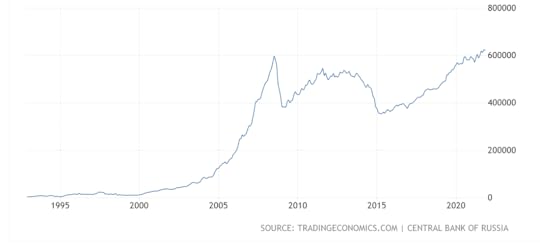
Source: Trading Economics
Hovering between $400 and $600 billion they are amongst the largest in the world, after those of China, Japan and Switzerland.
This is what gives Putin his freedom of strategic maneuver. Crucially, foreign exchange reserves give the regime the capacity to withstand sanctions on the rest of the economy. They can be used to slow a run on the rouble. They can also be used to offset any currency mismatch on private sector balance sheets. As large as a government’s foreign exchange reserves may be, it will be of little help if private debts are in foreign currency. Russia’s private dollar liabilities were painfully exposed in 2008 and 2014, but have since been restructured and restrained.
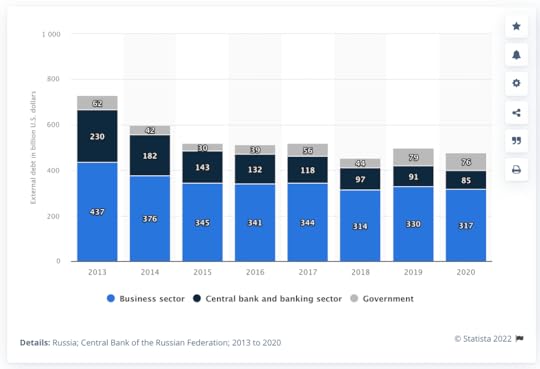
Source: Statista
According to data released by the Bank of Russia, Nominal foreign debt of banks and non-financial companies (corporate foreign debt) increased by US$6bn to US$394bn in 2Q21 (c.25% of GDP), easily covered by the foreign exchange reserves.
This strong financial balance means that Putin’s Russia will never experience the kind of comprehensive financial and political crisis that shook the state in 1998.
Nor was it by accident that it was as those foreign exchange reserves approached their first peak in 2008 that Putin began to articulate his determination to end the period of Russia’s geopolitical retreat. This is the second key element of the diagnosis.
Putin laid out his position in no uncertain terms in his sensational speech to the Munich Security Conference in February 2007 in which he outlined his comprehensive critique of Western power and Russia’s refusal to accept any further eastward expansion of NATO.
Today, China’s fundamental opposition to American hegemony articulated from within the global economy dominates the global scene. But the first to expose the fact that global growth might produce not harmony and convergence but conflict and contradiction, was Putin in 2007-8.
Putin’s stance produces outrage in the West. His assertion of Russia’s autonomy by all means necessary exposes the vanity of the post-Cold War order, that assumed that the boundary between different forms of power – hard, soft and financial – would be drawn by the Western powers, the United States and the EU, on their own terms and to suit their own strengths and preferences. The West has itself always employed a blend of strategies – financial pressure, soft power and military force – to achieve its goals. Russia’s challenge has forced a reshuffling of that pack and new combinations of diplomatic persuasion, soft power, financial and ultimately military threats and coercion. That this should be happening in Europe compounded the scandal.
The third essential point is that the consequences of this resurgence of Russian power depend on where you are and how you are set up to meet the challenge.
In Eastern Europe the crucial question is how Russia’s neighbors, whether former Soviet Republics, or former Warsaw Pact members navigated the staggering economic and social shocks of the 1990s. In this regard, Poland and the Baltics are at one end of the spectrum. They have rebounded from the 1990s crisis, have relatively high-functioning post-Communist polities and gained membership in NATO and EU in early waves of expansion. Ukraine is, in every respect, at the opposite end of the spectrum.
What makes Ukraine into the object of Russian power is not just it geography, but the division of its politics, the factional quality of its elite and its economic failure.
The end of the Soviet Union may have given Ukraine independence but for Ukrainian society at large it has been an economic disaster. Like Russia, Ukraine suffered a devastating shock in the 1990s. GDP per capita in constant PPP terms halved between 1990 and 1996. It then recovered to 80 percent of its 1990 level in 2007 and has stagnated ever since. Thirty years on, Ukraine’s GDP per capita (in constant PPP dollars as measured by the World Bank) is 20 percent lower than in 1990.
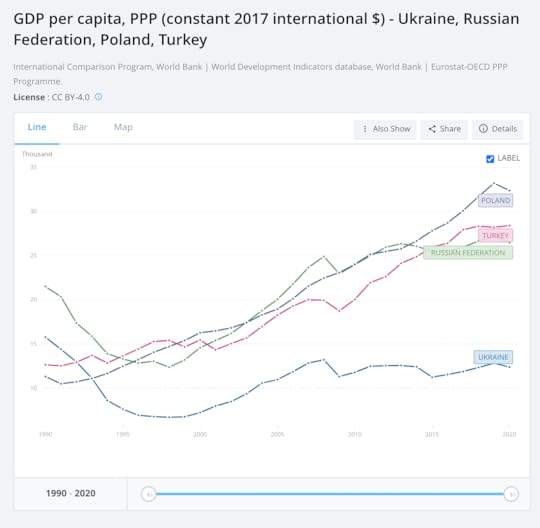
Source: World Bank
Ukraine’s experience contrasts sharply with that of Russian Federation which since the 1998 crisis has seen much more dramatic and sustained recovery. It also contrasts painfully with the growth trajectory of Ukraine’s neighbors Turkey and Poland.
GDP per capita numbers paint a picture of painful stagnation. In addition, Ukraine’s weakness have left it vulnerable to repeated and painful foreign exchange and financial crises, best summarized by the erratic chart of the hryvina’s devaluation against the dollar and euro. There were big shocks in the late 1990s. In 2008. In 2014-5. Since 2015 the hryvina has swung around a new plateau. Given the depreciated level of the currency, in percentage terms the swings are now smaller. But Ukraine continues to be a fragile ward of the IMF.
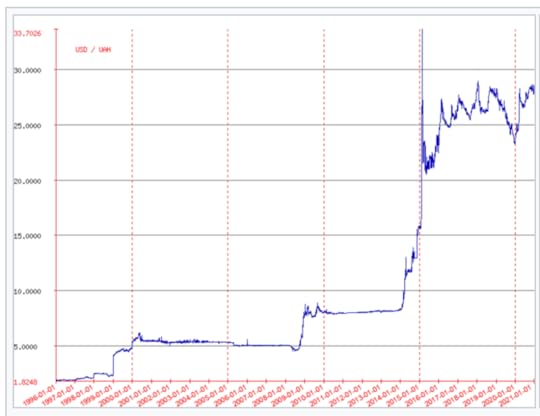
Source: Wikipedia
Russian nationalist simply dismisses Ukraine’s claim to statehood altogether. That is propaganda. But what is clearly true is that Ukraine’e elite have not come up with a formula for delivering the material basis of legitimacy, i.e. a minimum of stability and sustained economic growth. Economic frustration compounds the divisions between regions, language groups, factional interests. Since independence, the oligarchic super-rich have played a baneful and disruptive part in Ukraine’s politics.
When President Zelensky declared after his first encounter with Putin in the talks in Paris in December 2019, “Ukraine is an independent, democratic state, whose development vector will always be chosen exclusively by the people of Ukraine”, we should bear these basic economic facts in mind. Clearly, Zelensky wished to insist on Ukraine’s sovereignty vis a vis an overmighty Russia. But if sovereignty consists in determining a development vector – which does seem like a good definition – what can one say about Ukraine’s sovereignty? At best it could be described as a desperate and so far vain search for a development model that could command the support of a majority in Ukraine.
That desperate search was made more urgent by the rising geopolitical tension announced by Putin’s speech in 2007 and by the financial shock of 2008. But it was also made more dangerous.
The basic options as discussed before 2014 were alignment with Russia, alignment with the EU-NATO or balancing between the two. Balancing between the two was the mode preferred in the 1990s and early 2000s. But by the mid 2000s in the wake of the color revolutions in Georgia and Ukraine in 2004, with both Poland’s prosperity and Russia’s ambition increasingly evident, the choices began to seem more stark.
Then in 2008, the Bush administration sought to decide the issue. It encouraged both Georgia and Ukraine to aspire to NATO membership and wrangled the other NATO members, at the NATO Bucharest conference in April 2008 into promising them membership. This confirming Russia’s worst fears. Ever since Ukraine’s politics has been torn by the scale of this choice. The worst consequences were graphically illustrated in Georgia.
Following the Bucharest NATO summit, Georgia’s ambitious leadership under President Mikheil Saakashvili concluded that to expedite NATO membership it would need to resolve outstanding issues with the breakaway region of South Ossetia. It also imagined that it had received a green-light from Washington. In August 2008, just weeks ahead of the Lehman crisis, Moscow’s massive military reaction to Georgia’s offensive in South Ossetia sent a clear and decisive message. Do not attempt to move forward on NATO’s ill-judged Bucharest commitments.
If that was not enough, economic and financial crisis in US and Europe halted any further moves in that direction. In 2008 Ukraine was immediately thrown into appealing to the IMF. Given its reliance on heavy-industrial exports, Ukraine was one of the economies worst hit by the 2008 shock.
By 2013, Kiev was desperately trying to play off IMF, EU and Russia looking for a deal. The result in 2013 was a winner takes all bidding war between the EU and Russia for influence over Ukraine’s economy. Yankukovych’s corrupt regime first encouraged its population to believe that it was swinging towards the EU. Then, faced with the niggardly European financial terms, and with a far more lucrative offer from Moscow in hand, it swung abruptly back towards Russia. That triggered the Maidan revolution. With the West hastening to recognize the revolution, Yanukovych was unwilling to stand and fight. Faced with a fait accompli Russia decided to save what could be saved. In 2014 it annexed Crimea and intervened to create Russian-backed separatist Republics in the Eastern Donbass region.
This is where the current media story typically begins: “Russian aggression against sovereign Ukraine in 2014”.
Desperate to hold the Kiev regime together, the West instrumentalized the IMF under Christine Lagarde to provide financial assistance to Kiev. This was the first time that the Fund has made a program for a country in Ukraine’s unstable condition, with an ongoing conflict on its territory. But neither the EU nor the US had any intention of backing Ukraine sufficiently to win the war in the East. Instead, the Obama administration backed away and handed off the Ukraine crisis to France and Germany. In the so-called Normandy format negotiations – amidst the eruption of the Eurozone clash with the new Syriza government in Athens and the swelling refugee crisis (the original polycrisis) – Berlin and Paris =shepherded Ukraine into the Minsk II agreement in 2015. After years of alienation (remember Snowden 2013) it was a moment of restored US-German harmony.
The Minsk agreement of 2015 is key to the current crisis. The original deal was a reflection of Russia’s massive military superiority over Ukraine but also Russia’s unwillingness to escalate to the point of full-scale invasion. The deal satisfied Russia because it promised a decentralized Ukraine with language rights guaranteed for Russian speakers. That in Moscow’s view was enough to ensure that Ukraine would not slide into the Western sphere of influence. If no progress was made on implementing the deal, Ukraine would be left in a state of frozen conflict. The ongoing conflict might not stop IMF support, but it would rule Ukraine out as a candidate for closer integration with either the EU or NATO. But it is also a painful provisorium. It is deeply unsatisfying to the increasingly nationalist tone of politics in Kiev. Moscow found itself backing the Donbass region and having to adjust to life under a sustained sanctions regime imposed by the US and the EU.
Resolving the Minsk agreement impasse is what the argument has been about since 2019 when Zelensky was elected on a peace-ticket and President Macron of France took steps to revive the process in the hope of bringing Russia out of the deep freeze.
With Trump in the White House and increasing concern about China, France did not want to persist with the status quo. An independent Franco-European diplomacy towards Russia has been a fantasy since the days of De Gaulle. Germany has continued its economic relations with Russia regardless of the Ukraine crisis, notably in the energy sector. The agreement between Gazprom, Royal Dutch Shell, E.ON, OMV, and Engie to build Nordstream 2 was signed in the summer of 2015 and though it was put on ice, German permits were issued in January 2018 and construction on the German end began in May of that year.
But moving beyond the Donbass impasse requires concessions from both sides. Russia would need to concede at least independent monitoring of elections and institution-building in the Donbass segment it controls. And Ukraine and Russia would need to agree on the ultimate goal. To satisfy Russian concerns, Minsk envisioned a high degree of autonomy for the Eastern regions. The most Kiev is willing to agree to is the incorporation of Donbass into general structure of federation which does not go anywhere near far enough for Russia. Furthermore, after years of struggle Ukrainian nationalists regard any steps towards the actual implementation of the Minks agreement in a form that would be acceptable to Moscow, as an act of treason.
So if this is the backdrop to the impasse in Ukraine, and if 2019 seemed to open a new era of engagement, what I have been trying to figure out is what explains the current escalation to the point in which since the spring of 2021 we have had two major war scares in the period of 12 months. Furthermore, these are war scares of a different order of magnitude. .
Russian military analysts will tell you the Russia has been building capability for a while so it may simply have been a matter of time before they decided to wield this instrument of coercion.But that still begs the question of timing.
It is sometimes suggested that Putin needs a war scare for domestic political purposes. The annexation of Crimea in 2014 earned him a huge popularity bump. That has dissipated. There is little evidence from Lavarda polling data to suggest that the Russian population would welcome a new war and particularly not one with Ukraine.
It is true that since 2014 the gloss has come off Russia’s economy. Putin’s regime can no longer offer a good news story of an improving welfare bargain. In 2018 it raised the pension age, further undermining morale. As analysts at the Carnegie center have remarked, the Putin-era social contract – “you provide for us and leave our Soviet-style social handouts alone, and we’ll vote for you and take no interest in your stealing and bribe-taking” – has worn thin. In the autumn elections to the Russian parliament the legacy Communist party gained strength. But, again, that hardly provides a good reason for a sudden escalation to the current level of military tension.
The more compelling logic is driven by the tensions within the Minsk compromise, Russia’s geopolitical concerns about America’s stance, and Putin’s own political clock.
Inside the Kremlin, Putin’s own timeline is crucial. In 2024 he faces a choice as to whether to continue in power or to begin to prepare his final exit. Russia could step away from the Ukraine issue. But Putin is too dug in. He wants to resolve Ukraine. This does not mean annex it. It means achieving what the struggle between 2007 and 2015 was about i.e. drawing a line on western expansion. That needs to be achieved both by consolidating a Russian veto in Ukrainian politics and driving home the message to the West not to attempt a further expansion. If 2024 is the date that is on Putin’s mind, then this overlaps with the term of the Biden Presidency. So, setting the terms of Russo-US relations on the issue as early as possible must be a priority for the Kremlin. The Biden administration has clearly signaled that its priority is China and that it is willing to pay a political price for retrenching its strategic position (Afghanistan), perhaps that opens the door in Ukraine.
Then there are internal dynamics within Ukraine. The Western media tend to treat Russia’s commentary on Ukraine as purely instrumental talk. But what if we take seriously what the Russians say? In that case what they are concerned about is something like the Georgian scenario. An over-ambitious or desperate nationalist regime in Kiev, encouraged by loose Western talk about NATO membership, attempts, through force, to reincorporate Donbass. That would require Moscow to react with massive force. Better to resolve the issue on Moscow’s own terms by making clear the vast imbalance in military power and forcing the US to engage with the diplomatic process, out-maneuvering Berlin and Paris, which Moscow regards as helpless and pro-Ukrainian.
In 2018, Putin publicly declared that a Ukrainian attempt to regain territory in the Donbas region by force would unleash a military response.
The election in 2019 election of Volodymyr Zelensky was seen as potential opening. He ran as a peace candidate. He returned to the Normandy format negotiations and Russia put a lid on any violent clashes in Donbass. But Zelensky’s popularity has collapsed. Like all his predecessors he faces a choice between Russophone opposition based in the east of the country, and the nationalists rooted in Ukraine’s west. Like all his predecessors he is trying to deliver for the electorate whilst negotiating with the IMF. Ukraine’s economic situation continues to be miserable.
The divisions within Ukrainian politics continue to be extreme, with the nationalist exerting a whip-hand. In March 2020 Zelenskiy’s chief of staff, Andryi Yermak, met with the Putin’s point man Dmitry Kozak, and agreed on a special Advisory Council in which Ukrainian officials would discuss the peace process with representatives of the Russian-backed separatist governments. On his return to Kiev, Yermak was slapped with criminal charges by the Ukrainian security services and faced accusations of treason in parliament. This confirmed Moscow’s view that nationalist zealots in Ukraine call the shots.
Meanwhile, the NATO-Ukraine issue continues to bubble.
In early December 2019 the Ukrainian parliament adopted a resolution “regarding priority steps to ensure Ukraine’s Euro-Atlantic integration and acquire Ukraine’s full membership in the North Atlantic Treaty Organization.”
Nor was this simply an appeal from the Ukrainian side. According to Carnegie Moscow center’s Vladimir Frolov, the moment when Moscow’s strategic patience regarding the Zelensky government finally snapped was in June 2020, when NATO decided to grant Ukraine the status of Enhanced Opportunities Partner.
This was welcomed by a representative of Zelensky’s party as follows:
Lisa Yasko, Ukrainian MP, Servant of the People Party: NATO’s decision to grant Ukraine Enhanced Opportunities Partner status is great news. The Ukrainian government has been working on this issue since autumn 2019. Earlier obstacles resulting from misunderstandings with Budapest regarding Ukrainian language policy and education reforms have been resolved thanks to fruitful bilateral dialogue with Hungary. Enhanced cooperation between Ukraine and the NATO alliance is of the utmost strategic importance for regional and global security. EOP status gives us new opportunities in Ukraine, in Brussels, and across the globe. In particular, this opens up new possibilities for the further exchange of information and intelligence, mutual training, and the participation of the Ukrainian military in NATO missions. At the same time, it is important to underline that our claim for a NATO membership action plan remains valid. With this in mind, Ukraine continues to implement reforms in the security and defense sectors. In 2020 this includes the reform of military ranks in line with NATO standards. President Zelenskyy has also presented a bill on Security Service reform. This reflects our ongoing commitment to greater Euro-Atlantic integration. Over the summer of 2020, there was talk in Kyiv of attaining the status of Major Non-NATO Ally, which would remove virtually all restrictions on military cooperation with the Americans.” That is probably the main Russian worry at this point.
As far as the Carnegie team working under Dmitri Trenin can judge, this was a crucial turning point.
Moscow, however, did not immediately move to a war footing. In the second half of 2020 it had to deal with two other major crises in its immediate neighborhood. In August the rigged presidential elections in Belarus triggered an unprecedented storm of protest. In September 2020 war broke out between Armenia and Azerbaijan, with Azerbaijan, backed by Turkey, scoring a major victory. A fragile peace was achieved in November 2020 with Moscow acting as the broker.
Both of these crises could have provided a reckless regime in Moscow with opportunities for dramatic intervention. In neither case did Moscow push hard. In the Caucasus conflict it has adopted a balancing position. In Belarus Moscow’s aim seems to be largely defensive, to avoid what for Putin would be a Maidan-style distater. But it has not foisted on Lukashenko a complex or expensive new integration with Russia. The Russo-Belarusian integration agreement of November 2021 is an empty letter. With Lukashenko beginning to plan his exit,
the main objective for the Kremlin is to maintain a controlled, pro-Russian transition of power. It wants to prevent Lukashenko and the Belarusian elite from casting around in search of new allies and hatching harebrained schemes. Such behavior might escalate the domestic situation and prompt the EU and the United States to look for new approaches, which might again steer Belarus toward the West.
As for Ukraine, the decisive escalation in the spring of 2021 was triggered by actions taken on the Kiev side over winter of 2020-2021.
In December Ukrainian Defense Minister Andrii Taran announced that Ukraine hopes to receive a NATO Membership Action Plan (MAP) at the upcoming NATO summit.
He stated this at a briefing entitled “Defense aspects of Ukraine’s Euro-Atlantic integration: key aspects and tasks for the future,” according to the Ukrainian Defense Ministry’s website.
“Please inform your capitals that we count on your full political and military support for such a decision [granting Ukraine the MAP] at the next NATO summit in 2021. This will be a practical step and a demonstration of commitment to the decisions of the 2008 Bucharest Summit,” Taran said, addressing the ambassadors and military attaches of NATO member states, as well as representatives of the NATO office in Ukraine.
According to him, today Ukraine’s course for full membership in NATO is enshrined in the Constitution of Ukraine, and the rapid receipt of the NATO Membership Action Plan is a goal set in the recently adopted National Security Strategy of Ukraine. Taran noted that over the past seven years, Ukraine has firmly defended not only its own independence, but also the security and stability of Europe, and acts as a powerful outpost on NATO’s eastern flank.
“We believe that Ukraine and Georgia’s joining the Alliance would be the right decision for NATO. Our countries have a lot in common. These are post-Soviet republics, the countries that have been affected by Russian aggression. From our point of view, Ukraine’s and Georgia’s potential membership in NATO will have a significant impact on Euro-Atlantic security and stability, in particular in the Black Sea region,” Taran said.
2021 February, in an unexpected move the Ukrainian authorities announced severe sanctions against pro-Russian politicians and media. On February 2, Zelensky shut down three pro-Russian TV channels, accusing their owner of financing Donbas separatists. This was followed on February 19 by sanctions against Ukrainian and Russian individuals and companies on the same charges. Most dramatically, Kiev struck against Viktor Medvedchuk, who in recent years has been Putin’s only interlocutor in Ukrainian politics and is a crucial go between. Given the strong support for his pro-Russian party Medvedchuk was also a serious challenger to Zelensky in political terms.
Clearly this merited a reaction from Moscow. In direct response, Moscow unleashed the separatist forces in Donbass resulting in a surge in ceasefire violations. But intensifying the fighting in Donbass was one thing, why the full-scale military mobilization?
Here the military logistical issues may play a role. Russia has the means. But it also had the motive not simply to intimidate Kiev but to test the relationship between Kiev and Washington. It was in early 2021 that Moscow source began to refer more often to Mikheil Saakashvili syndrome. Would Zelensky attempt something similar in Donbass in 2021, in the expectation of American support?
The Kremlin does not treat Ukrainian politics very seriously. They are strongly convinced that the real force in deciding Kiev’s actions is Washington. Russia had nothing good to expect from an in-coming Democratic administration and Biden had made clear his determination to take a firm line in the campaign. The attack on Alexei Navalny and his jailing added further tension. By raising the military pressure on Kiev, Moscow would test Biden’s mettle and make clear that if the Ukraine situation was to be resolved, then Washington could not rely on Europe to deliver a resolution by means of the Minsk process.
During the crisis, Kozak, who is also the Kremlin’s deputy chief of staff, essentially repeated President Vladimir Putin’s earlier stern warning that a Ukrainian offensive in Donbas would spell the end of Ukrainian statehood. And Washington responded.
Throughout 2021 the Biden administration has walked a line between seeking a working relationship with Russia and responding to pressure to take a strong stance on what are judged to be Russian provocations. Given that the Biden administration’s clear focus is on China it is striking how much attention has been directed towards Russia.
From this initial escalation in the spring, triggered by Zelensky’s moves against pro-Russian political forces, by way of the telephone diplomacy with Biden, which led to a deescalation in April, to the June summit in Geneva, the sparring in the summer, and the reescalation of tension since August, we can retrace the steps which by November led back to an acute war scare.
On the Russian side, one significant moment in the longer-term may turn out to be the publication on 2 July 2021 of Russia’s new National Security Strategy. Even more explicitly than its predecessor document of 2015 it sets out a new and antagonistic view of the world.
On the Ukrainian side one might point to the Crimean Platform summit that president Zelenskiy opened in Kiev on 22 August, “to build pressure on Russia over its annexation of the Crimea territory, …Officials from 46 countries and blocs are taking part in the two-day summit, including representatives from each of the 30 NATO members. The U.S. delegation is headed up by Secretary of Energy Jennifer M. Granholm.”
The structure of this conflict is clear as are the routes which generate escalation. The question is, can it be resolved? Personally I am sympathetic to Anatol Lieven’s take in the Nation. Or the proposal by Thomas Graham (NSC Russia Director for George W Bush) and my colleague Rajan Menon in Politico.
Whichever route one proposes, it will be a disaster for US grand strategy if the upshot of the current crisis is a military escalation or an increase in hostilities with Russia that drives if further towards China. The Putin-Xi summit is already scheduled for the winter Olympics in February.
****
I love putting together Chartbook and am delighted it goes out free to thousands of subscribers. But if you like what you are reading and feel you can support the effort, please pick one of the subscription offers here:
January 9, 2022
Chartbook #67: In the middle of things (sic) -Hommage to Tsing’s Mushroom at the End of the World
Amongst the books that affected me most in 2021 was Anna Lowenhaupt Tsing’s The Mushroom at the End of the World, a study of communities of mushroom pickers in the Pacific Northwest, Yunnan China and Kyoto Prefecture, Japan.
Out of this seemingly obscure topic, out of its obscurity Tsing weaves a dizzying account of capitalist modernity. It is a study, as her subtitle has it, of “the possibility of life in capitalist ruins”.
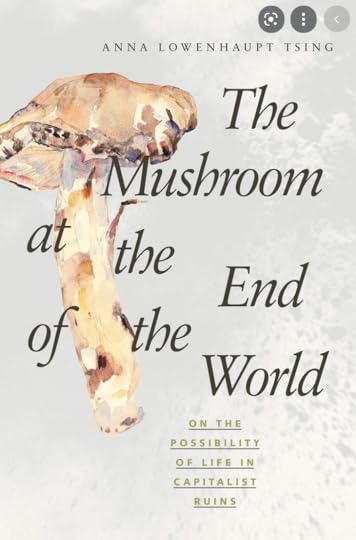
On the second reading I was struck by the way that a book that celebrates story-telling and story-collecting, is at the same time cross-cut by a set of concepts, methodological reflection and something akin to a philosophy of history. I found it utterly fascinating. And then I realized the title that Tsing had chosen for her Part IV was “in the middle of things” (in medias res) and, well, that really set me off.
What follows are a series of quotations and short excepts from the book with brief commentary from me. To avoid any possibility of confusion I have italicized the passages from Tsing’s book.
Throughout the book, Tsing evokes musical analogies and metaphors. It is a strange, haunting, mysterious, challenging piece of music. I won’t pretend that everything about this book is totally clear to me. For me it has a poetic appeal. I find it all the more compelling for that.
***
What unites the mushroom growing and collecting communities that Tsing describes is the Matsutake, a kind of mushroom particularly prized in traditional Japanese cuisine that is highly sensitive to forest conditions and grows particularly well in abandoned/(ruined) industrial forests.
It is not a comparative study, so much as a study of interconnection, of “patches” as Tsing puts it. Implicitly, however, it is framed, as it must be, by her own position as an Asian American reflecting on the very different experience of assimilation to the US that characterized her family’s experience and that of migrants to the US arriving in the era of neoliberalism in the wake of the Vietnam war. Some of the pickers in the Oregon forests are White Vietnam veterans. There are also large communities of Cambodians and Hmong from Lao. Many of them are marked by war. But Tsing’s narrative is anchored in mid-century, in World War II.
After the War
After the war, the promises of modernization, backed by American bombs, seemed bright. Everyone was to benefit. The direction of the future was well known; but is it now? (3)
But those certainties are gone. They have evaporated since the 1970s.
Tsing challenge is to understand how we live and think the world without those “handrails, which once made us think we knew, collectively, where we were going. (2)
To appreciate the patchy unpredictability associated with our current condition, we need to reopen our imaginations. The point of this book is to help that process along—with mushrooms. (4-5)
Matsutake are a place to begin: However much I learn, they take me by surprise. (6)
Thus we arrive at her somewhat surprising question.
(W)hat kind of economy is this anyway? (4)
By way of informal mushroom gatherers we arrive at the question:
How might capitalism look without assuming progress?
Tsing’s answer: It might look patchy. (5)
… I find myself surrounded by patchiness, that is, a mosaic of open-ended assemblages of entangled ways of life, with each further opening into a mosaic of temporal rhythms and spatial arcs. I argue that only an appreciation of current precarity as an earthwide condition allows us to notice this—the situation of our world. As long as authoritative analysis requires assumptions of growth, experts don’t see the heterogeneity of space and time, even where it is obvious to ordinary participants and observers. Yet theories of heterogeneity are still in their infancy. (4)
Tsing’s is a contribution to the thinking of heterogeneity. Hence her central question: How do we know “capitalism beyond its heroic reifications”. (x)
The inspiration here is the feminist critique of political economy developed amongst others by J. K. Gibson-Graham (the pen name shared by feminist economic geographers Julie Graham and Katherine Gibson).
In approaching capitalism beyond heroic reifications we will do better not to begin with pristine nature (1st nature), or with the capitalist machine, the factory. We will do better if we start with ruins, “spaces of abandonment for asset production. Global landscapes today are strewn with this kind of ruin.” (6)
As Tsing insists, we must then also refuse the obvious temptation when confronting a ruin, to assume that they are, in fact, abandoned and dead. “these places can be lively despite announcements of their death; abandoned asset fields sometimes yield new multispecies and multicultural life.” (6)
Nor should we linger over ruins out a sense romance. We should recognize our own situation. For us, ruins are not a tourist attraction. They are our condition.
“In a global state of precarity, we don’t have choices other than looking for life in this ruin.” (6)
In an extended sense the very atmosphere that wraps around our planet, burdened as it is with our emissions, is a ruin.
History & progress
If we acknowledge our precarity, we give up the promise of a certain future but gain a recognition of a certain, limited kind of freedom.
“A precarious world is a world without teleology. Indeterminacy, the unplanned nature of time, is frightening, but thinking through precarity makes it evident that indeterminacy also makes life possible.” (20-21)
Even stating these facts is unsettling. As Tsing nicely points out, such statements take us two ways. “The only reason all this sounds odd is that most of us were raised on dreams of modernization and progress.” And on the other hand, as critical contemporaries, we also imagine ourselves free from such illusions.
“… I imagine you talking back: “Progress? That’s an idea from the nineteenth century.” The term “progress,” referring to a general state, has become rare; even twentieth-century modernization has begun to feel archaic.” (21)
But. Tsing doesn’t buy it. The categories and assumptions of progress are everywhere. “we imagine their objects every day: democracy, growth, science, hope. Why would we expect economies to grow and sciences to advance? … our theories of history are embroiled in these categories. So, too, are our personal dreams.” (20-21)
Refreshingly, she fully admits to her own unease amongst the postmodern mushroom pickers. She does not indulge in any romantic embrace of the neo-primitive.
“abandoning progress rhythms … is not a matter of virtuous desire. Progress felt great; there was always something better ahead. Progress gave us the “progressive” political causes with which I grew up. I hardly know how to think about justice without progress.” (24-25)
“I admit it’s hard for me to even say this: there might not be a collective happy ending.” (21)
Beyond specific political agendas and programs, progress is embedded in our very notions of what it means to be human. Our attachment to progress in the most general sense is what separates us from what we define as animals.
“Even when disguised through other terms, such as “agency,” “consciousness,” and “intention,” we learn over and over that humans are different from the rest of the living world because we look forward—while other species, which live day to day, are thus dependent on us. As long as we imagine that humans are made through progress, nonhumans are stuck within this imaginative framework too.” (21)
Abandoning the promise of progress is not easy. It is not virtuous. It is, according to Tsing, simply realistic.
“The problem is that progress stopped making sense. More and more of us looked up one day and realized that the emperor had no clothes.” (24-25)
The question is how to equip ourselves for this new reality.
Curiosity versus despair
One thing we need to guard against is despair. Declinism may be seductive. But, in its simple negativity, it signals a lingering attachment to its opposite, i.e. progress.
I am not proposing a story of decline. The story of decline offers no leftovers, no excess, nothing that escapes progress. Progress still controls us even in tales of ruination. (21-2)
What we need to muster are the tools and arts of “noticing” and the curiosity to notice new things that we may be able to hear, now that the pounding rhythms of progress have lost their force (24-5).
It is time to reimbue our understanding of the economy with arts of noticing. (132)
To recognize this fact and begin to come to terms with it, we need precisely to overcome our preconceptions and sense of déjà vu.
“Our first step is to bring back curiosity. Unencumbered by the simplifications of progress narratives, the knots and pulses of patchiness are there to explore.” (6)
How then are we to think this reality beyond, progress and decline?
The concept of assemblage is helpful. (22)
It is common to think of capitalism as a machine. A machine has a clearly defined purpose and a number of particular parts.
A factory is a giant machine. A plantation is designed to be a machine. It is tempting to think of all sorts of things as machines that are actually not.
Mushroom picking for Tsing is fascinating precisely because it is, in her words, the “anti-plantation” (37), the anti-factory, the anti-machine, an assemblage.
The mushroom economy, is an economy. It generates considerable value. But it is an assemblage not a machine.
Assemblages for Tsing are comings together of people and animals and things. They do not constitute firm and clear identities. They have no clearly defined boundaries. But they are powerfully productive. They are well-suited to navigating the terrain of ruins.
The time of assemblages
Interestingly, for Tsing this heterogeneous notion of an aggregate, that avoids the notion of a fixed totality, or a closed system, or a thing with clearly defined boundaries, also offers a different way of understanding time and history.
If history without progress is indeterminate and multidirectional, might assemblages show us its possibilities? (23)
So far, I’ve defined assemblages in relation to their negative features: their elements are contaminated and thus unstable; they refuse to scale up smoothly. Yet assemblages are defined by the strength of what they gather as much as their always-possible dissipation. They make history. This combination of ineffability and presence is evident in smell: another gift of the mushroom. 43
Assemblages don’t just gather lifeways; they make them. (24)
Assemblages are open-ended. They show us potential histories in the making. (23)
Thinking through assemblage urges us to ask: How do gatherings sometimes become “happenings,” that is, greater than the sum of their parts? (24)
And before your attention wanders amidst all these abstractions, Tsing brings us back to earth.
Surprisingly, this turns out to be a method that might revitalize political economy as well as environmental studies. Assemblages drag political economy inside them, and not just for humans. … Assemblages cannot hide from capital and the state; they are sites for watching how political economy works. If capitalism has no teleology, we need to see what comes together—not just by prefabrication, but also by juxtaposition. 23-24
This you might say is the metaphysics of “supply-chains”.
The polyphonic assemblage … moves us into the unexplored territory of the modern political economy. The farther we stray into the peripheries of capitalist production, the more coordination between polyphonic assemblages and industrial processes becomes central to making a profit. (24)
Categories
Assemblages defy definition. They challenge the conventional categories of social theory, modernization theory, developmental economics etc. And Tsing embraces this. It is freeing.
Her method, “follows … multiple temporalities, revitalizing description and imagination. This is not a simple empiricism, in which the world invents its own categories. Instead, agnostic about where we are going, we might look for what has been ignored because it never fit the time line of progress. (21)
But she also immediately acknowledges the problem it poses. How are we to characterize assemblages without categories?
… using category names is problematic. But not to use them is worse because then everything is alike, or everything is individually different. Both undifferentiated. 29
So what then are we to do? Forcing assemblages into categories betrays their complexity and open-endedness. They are not things.
On the other hand, not to apply categories leaves us with no way of differentiating between types of assemblages.
Tsing’s answer is pragmatic. It is a commitment to enquiry.
If categories are unstable, we must watch them emerge within encounters. To use category names should be a commitment to tracing the assemblages in which these categories gain a momentary hold. 29
And when we trace the making and unmaking of assemblages and how categories sometimes take hold, what will we find?
If we assume difference. If we assume heterogeneity and divergence, “(w)hat calls out for explanation, then, is when they happen to converge. In these moments of unexpected coordination, global connections are at work. But rather than homogenizing forest dynamics, distinctive forests are produced despite the convergences. It is this process of patchy emergence within global connection that a history of convergences can show. (206)
Scale
So we are going to set aside the noisy narratives of progress and decline. We are going to cultivate the art of noticing. We are going to listen to the stories that actors tell and we will recognize and valorize that story-telling as a method. Indeed, Tsing insists, why not make the strong claim and call” (37) this gathering of stories, “a science, an addition to knowledge? Its research object is contaminated diversity; its unit of analysis is the indeterminate encounter(s)” (37) Out of all this assemblages emerge.
But this leaves us with a problem. Stories are stories. Just that. The question is what we do with such anecdotage. Can we scale it up? Stories undeniably have the power to convey meaning, but how far do they reach?
Again, Tsing does not simply side with the anecdote, the small or the particular. Instead, she reframes the problem.
Arts of noticing are considered archaic because they are unable to “scale up” in this way. The ability to make one’s research framework apply to greater scales, without changing the research questions, has become a hallmark of modern knowledge. To have any hope of thinking with mushrooms, we must get outside this expectation. 37-8
The striking thing here is the parallelism that Tsing establishes between her object and her way of knowing it. The mushroom economy is not a machine. It does not scale. It is radically particular. And yet, it generates value. It has reach. The same is true for the knowledge that she is generating about this far flung global network of mushroom harvesting, valorization and consumption.
In this spirit, I lead a foray into mushroom forests as “anti-plantations.” The expectation of scaling up is not limited to science. Progress itself has often been defined by its ability to make projects expand without changing their framing assumptions. This quality is “scalability.” The term is a bit confusing, because it could be interpreted to mean “able to be discussed in terms of scale.” Both scalable and nonscalable projects, however, can be discussed in relation to scale. (37-8)
Scalability, in contrast, is the ability of a project to change scales smoothly without any change in project frames. A scalable business, for example, does not change its organization as it expands. This is possible only if business relations are not transformative, changing the business as new relations are added. Similarly, a scalable research project admits only data that already fit the research frame. Scalability requires that project elements be oblivious to the indeterminacies of encounter; that’s how they allow smooth expansion. Thus, too, scalability banishes meaningful diversity, that is, diversity that might change things. Scalability is not an ordinary feature of nature. Making projects scalable takes a lot of work. (38)
Tsing, by contrast, is advancing a nonscalable knowledge of nonscalability. It starts, as she says, by exposing the “work it takes to create scalability—and the messes it makes. One vantage point might be that early and influential icon for this work: the European colonial plantation.” (38)
Hence the interest of economies built on mushrooms that grow amidst the wreckage left amidst the detritus of plantation forestry, an opportunity for far-reaching but nonscaleable knowledge.
Back to the large
Does this focus on mushrooms consign Tsing to the esoteric? Does it provide only, “the view from a frog in a well?” No, she replies, “On the contrary.”
Why? Because modernity’s own account of capitalism, in the grand heroic, progressive mode is self-deluding. In fact, capitalism always operates in multiple modes. Capitalism in its development has of course, seen the gigantic development of machine-like, scalable production, distribution and consumption. But, the totality it pretends to, is never complete. It exists alongside, depends on and helps to create new models of economy that operate in salvage mode, amongst ruins in the manner of assemblages. And successive histories are layered upon each other.
“the modest success of the Oregon-to-Japan matsutake commodity chain is the tip of an iceberg, and following the iceberg to its underwater girth brings up forgotten stories that still grip the planet. … It is the very negligible quality of the matsutake commodity chain that hid it from the view of twenty-first-century reformers, thus preserving a late-twentieth-century history that shook the world. This is the history of encounters between Japan and the United States that shaped the global economy. Shifting relations between U.S. and Japanese capital, I argue, led to global supply chains—and to the end of expectations of progress aimed toward collective advancement.” (109-110)
Tsing’s provocative thesis, is that Matsutake, which hit their prime in the late 1980s and early 1990s when the Japanese boom was at its height, are a relic and evolution of the Japanese mode of merchant capitalism that transformed the world from the late 1960s onwards. They are a memento of the arrival of the “Reverse Black Ships” that “propelled the U.S. economy into the world of Japanese-style supply chains.” (110)
And again Tsing refuses any simple periodization or stage theory.
Yet it would be a mistake to see matsutake commerce as a primitive survival; this is the misapprehension of progress blinders. Matsutake commerce does not occur in some imagined time before scalability. It is dependent on scalability—in ruins. Many pickers in Oregon are displaced from industrial economies, and the forest itself is the remains of scalability work.(40-41)
And likewise it would be a mistake to fall into any easy normative assessment. The aim of her analysis is to register and analyze “scaleability and nonscaleability” free of progress narratives and their obverse. But free also of premature judgement. “it would be a huge mistake to label one good the other bad” (42). The difference is not ethics but greater or lesser diversity enabled by the imperatives of scale and the open-endedness of the assemblage. 42
Capitalism
So, we arrive at this fascinating de-reified, non-heroic description of capitalism. Capitalism is a translation machine.
In collecting goods and people from around the world, capitalism itself has the characteristics of an assemblage. However, it seems to me that capitalism also has characteristics of a machine, a contraption limited to the sum of its parts. This machine is not a total institution, which we spend our lives inside; instead, it translates across living arrangements, turning worlds into assets. But not just any translation can be accepted into capitalism. The gathering it sponsors is not open-ended. An army of technicians and managers stand by to remove offending parts—and they have the power of courts and guns. This does not mean that the machine has a static form. As I argued in tracing the history of Japanese-U.S. trade relations, new forms of capitalist translation come into being all the time. Indeterminate encounters matter in shaping capitalism. Yet it is not a wild profusion. Some commitments are sustained, through force. (133)
Part II Chapter 7 What happened to the state?
If Tsing de-reifies capitalism and seeks to release her account from the imperatives of progress narratives, the same is true for her thinking about the state.
This for her has a personal dimension. Between the arrival of Japanese Americans, who first appreciated Oregon’s mushrooms and her mother’s arrival from China after World War II, and the coming of Lao and Cambodian Americans in the 1980s. “something important has changed in the relationship of the state and its citizens. The pervasive quality of Japanese American assimilation was shaped by the cultural politics of the U.S. welfare state from the New Deal through the late twentieth century. The state was empowered to order people’s lives with attractions as well as coercion. Immigrants were exhorted to join the “melting pot,” to become full Americans by erasing their pasts.” (101) For those who arrived in the 1980s that was no longer true.
“The freedom they had endorsed to enter the United States (as anti-Communist allies of the US) had to be translated into livelihood strategies. Histories of survival shaped what they could use as livelihood skills.” (102) That is what they were living out in the forest gatherings and market-places of the Oregon backwoods: A scant notion of freedom, organized no longer around a a state, but as an assemblage.
Nor was the American state as a physical presence, any longer an effective force in organizing the forest itself. Tsing’s account of the American forestry officials she encountered could hardly be more downbeat.
Their programs, they said, were a series of experiments, and most all of them had failed. 194
Since there was no good alternative, they just kept trying. (194)
What of Politics?
Deprived of the progress narrative. With freedom occupied as a term, what is the scope for creative, constructive, “progressive” politics, amidst ruins, amidst assemblages?
This is no doubt a problem for Tsing, as it is for every observer of the contemporary scene. She offers no easy answers.
She resists any attempt to cast the forest hunter-gatherers as workers. Indeed, resisting work is a key part of their project.
The closest she comes to sketching a vision of transformative politics comes in the passages in which she describes the activities of Beverly Brown a legendary organizer who bought pickers and the Forest Services together.
It was the determinacy of political categories such as class—their relentless forward motion—that brought us the confidence that struggle would move us somewhere better. Now what? Brown’s political listening addresses this. It suggests that any gathering contains many inchoate political futures and that political work consists of helping some of those come into being. Indeterminacy is not the end of history but rather that node in which many beginnings lie in wait. To listen politically is to detect the traces of not-yet-articulated common agendas. (253)
Listening, noticing – that is the procedure.
But what are you listening for? Beyond the certainties of progress and the identities offered by categories like class, what Tsing holds out is the possibility of a “latent commons”, entanglements that might be mobilized in a common cause. But those cannot be presupposed, or projected onto a situation.
the hints of common agendas we detect are undeveloped, thin, spotty, and unstable. At best we are looking for a most ephemeral glimmer. But, living with indeterminacy, such glimmers are the political. (253-5)
Part IV in the middle of things (251)
Tsing wants us to think and act from the middle of things, a suggestion I find very appealing. I tend to think that problem temporally. We think from within the flow of time. Tsing acknowledges that and adds another dimension.
Tsing wants us to think from places, in a situated way, from and about the histories of places, as in her mushroom patches and their complex histories. Science should not be more reified than capitalism or the state.
For Tsing the concept that links thought, history and place, is disturbance. Disturbances alter ecologies. They result from actions, human or non-human. They mark differences. They are points of entry.
This part of the book begins with disturbance—and I make disturbance a beginning, that is, an opening for action. Disturbance realigns possibilities for transformative encounter. Landscape patches emerge from disturbance. 152
She is worried that her emphasis on “disturbance” will be taken to imply the prior existence of an “undisturbed” state. So she insists:
as a beginning, disturbance is always in the middle of things: the term does not refer us to a harmonious state before disturbance. Disturbances follow other disturbances. 160
And then in the final sections of the book she adds this further specification. To be in the middle of things is a matter of time. It is a matter of place. It is also a matter of people, of society.
Muddling through with others is always in the middle of things. …. it does not properly conclude. Even as I reiterate key points, I hope a whiff of the adventure-in-process comes through. (277-8)
Muddling through with others (human and non-human) is Tsing’s answer to the overwhelming, gigantic and radically anthropocentric notion of the anthropocene.
Conjunctures
But once again, as is so characteristic of her restless thought, Tsing is not satisfied with tying us to a particular place.
The hard work—and the creative, productive play—of science, as well as emerging ecologies, happens in patches. But one might also sometimes wonder: What moves beyond them, making them? (227)
A patch becomes a patch after in relation to something else, in relation to other patches. And those patches are sometimes linked, to form interconnections and conjunctures, moments of coordination (118).
Not by a giant historical frame, but by more accidental and haphazard connections.
Sometimes conjunctures are the result of international “winds,” the term Michael Hathaway uses to describe the force of traveling ideas, terms, models, and project goals that prove charismatic or forceful (206)
In a phrase I adore, Tsing describes her own role in exploring this world thus:
I work the conjunctures … (163)
I work the conjunctures. Like working the winds. And then some pages further on, by way of comfort, she adds:
Luckily, in doing so, there is still company, human and not human. (282)
Good mottos to take from an extraordinary book.
*****
I love putting out Chartbook for free to a wide and diverse range of subscribers from all over the world. It is a pleasure to write and a great place to pull ideas together. It is also, however, a lot of work. If you feel moved to support the project, there are three subscription options:
The annual subscription: $50 annuallyThe standard monthly subscription: $5 monthly – which gives you a bit more flexibility.Founders club:$ 120 annually, or another amount at your discretion – for those who really love Chartbook Newsletter, or read it in a professional setting in which you regularly pay for subscriptions, please consider signing up for the Founders Club.January 7, 2022
The Economics of the Beatles vs. the Rolling Stones
Season 1, Ep. 15
After watching the Beatles: Get Back sessions, Cameron Abadi was inspired to dive deeper into the economics of the Beatles versus the Rolling Stones with Adam Tooze. So, rock lovers rejoice, that’s what you’ll get in the second half of Ones and Tooze this week.
But first, Tooze and Abadi dig into the heated online debate over price controls. For those not following, the internet somewhat broke over a Guardian op-ed arguing that price controls could fight inflation. Tooze tempers the hysteria and looks at the historic data.
January 6, 2022
Chartbook #66: More on inflation and price controls
“The price per liter of LPG jumped to 120 tenge (28 U.S. cents) at gas stations in hydrocarbon-rich Mangystau – where up to 90% of vehicles run on LPG – at the start of this year, compared to the price of 50-60 tenge the year before, igniting the unrest.
The nearly 100% rise that doubled the prices in the oil-rich region prompted almost countrywide demonstrations. The unrest has already prompted the nation’s president to sack the Cabinet on the fourth day of the protests.” Source: Daily Sabah
Debates about price controls are getting out of hand https://t.co/daZjCYhe9a
— Max Jerneck (@MaxJerneck) January 6, 2022
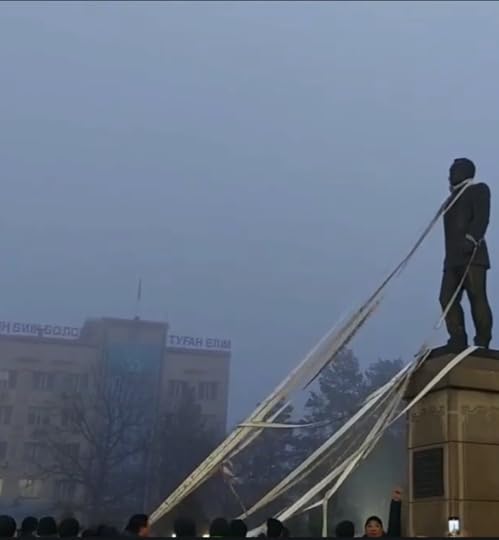
Hands up anyone who predicted that we would start 2022 by discussing strategic price controls, 1971, 1946 and the crisis of the Kazakh regime.
This thread has great meme game:
The Guardian piece on price controls really triggered people. Alan Blinder wrote a famous paper on why these were ineffective in the 70s, only changing the timing of inflation rather than its magnitude: https://t.co/o7hqc76Ene
— Dario Perkins (@darioperkins) December 30, 2021
On the US situation and price controls
On the original piece by Isabella Weber on price controls that triggered this entire debate, I still like this thread by Eric Levitz and the piece it is attached to.
Jotted down a few thoughts on the burgeoning debate over price controls/other unorthodox approaches to inflation management:
— Eric Levitz (@EricLevitz) January 2, 2022
Anti-inflation tools:
For a wide ranging consideration of different anti-inflation measures, this by Buddy Yakov is excellent.
The first layer is an industrial policy designed to push forward innovative production and make sure there are sustainable supply chains for that production.The second layer is a savings and incomes policy that guarantees demand by putting a floor under consumption but also encourages households to invest in public instruments and thus put some caps on consumption.The third layer should be credit and price controls meant to tamper down on extremely volatile components of CPI.The fourth layer – the red button – should then be aggressive interest rate hikes.We are left with a huge set of tool kits to deal with prices. I like to see it as a layer cake:
The purpose of this post is to discuss some ideas for how to deal with short-term inflationary bouts to pave the way for a wage-led economy. In addition to commenting on the hikes v. price controls debate that Weber’s article has inspired, I want to propose another way – deferring consumption via public savings. This is the proposal made by Keynes during the Second World War and is also present in Adolph Lowe’s theory about how to cross a traverse toward a full-employment economy.
Inflation Management
This piece by By Skanda Amarnath and Arnab Datta of Employ America, is very interesting:
Policymakers outside of the Fed can get ahead of this scenario by proactively adopting an “inflation management” approach that better achieves its policy goals. This does not have to mean Nixonian price controls. It means that the White House and Congress should, where feasible, use targeted fiscal policies and structural reforms to equitably address the demand- and supply-side challenges that contribute to inflationary pressure.
Healthcare as a sector is unique in terms of the influence that the federal government can exert over inflationary dynamics through legislation and regulation. It also makes up about a quarter of the Fed’s preferred real-time gauge of forward-looking inflationary pressures–”core PCE.” Rent inflation is likely to contribute more substantially to inflation readings in 2022 (0.4% additional contribution according to our forecasts), but those effects can also be entirely offset with healthcare policies that current law and proposed rulemaking already favors.
Profits and Prices
For a skeptical take on the relationship between profits and prices, I quoted the fantastic piece by Joey Politano. Here is Joey Politano is being super charming and very modest.
I just have to clarify that I'm not an economist at BLS—the work I do there is financial/budgetary and I don't have a graduate degree in Econ.
— Joey Politano
I know it seems pedantic, but as a federal employee I have to be careful not to misrepresent myself.(@JosephPolitano) January 3, 2022
Thomas Philipon one of the key economists on profit-gouging weighed in here:
1/n. My take on this question of monopoly power and inflation: two things are true at the same time:
— Thomas PHILIPPON (@ThomasPHI2) January 4, 2022
1/ The proximate cause for inflation is not a sudden increase in monopoly power.
2/ High demand and inflation suggest now is a good time to crack down on monopoly rents. https://t.co/IiPuH6GpOK
Office of Price Administration and all that
Before Isabella Weber made her case for price controls with reference to the 1940s, David Stein did something similar in Democracy Journal.
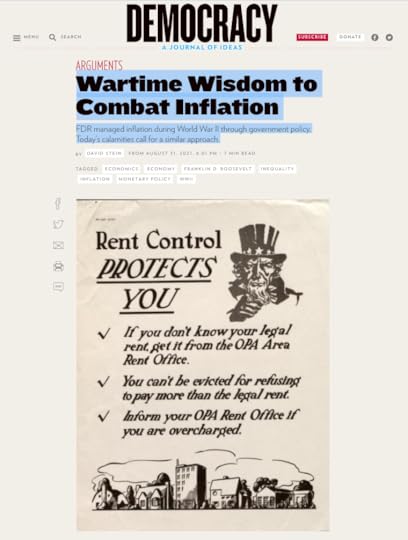
In this way, wartime frugality became an explosive political flashpoint. The rural South was outraged that preachers and ministers were not considered essential, and so Franklin Delano Roosevelt was too. He called in John Kenneth Galbraith, his lieutenant in price management with the Office of Price Administration (OPA), to ask him to ensure that ministers received their proper designation.
During World War II, pricing and production were too important to let the market bid up the cost of war material. Tires, cars, coffee, sugar—these were issues of critical national security. The size of the OPA reflected this; its staff of 250,000 was rivaled in the federal bureaucracy only by the Post Office. OPA had twice the number of economists as the Treasury Department; its decisions made front-page headlines.
Amongst historical references, David Stein cites the work by Meg Jacobs Pocketbook Politics: Economic Citizenship in Twentieth-Century America published by Princeton UP
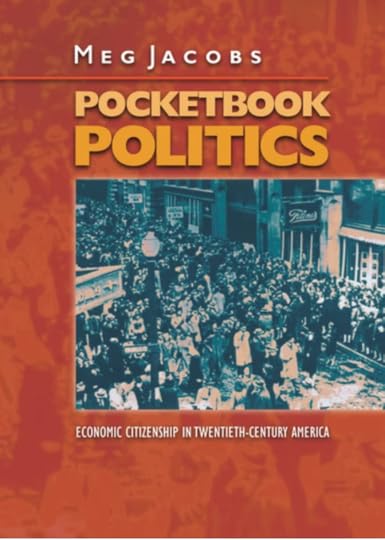
Wirtschaftswunder
One of the discoveries for me in Isabella Weber’s interesting book about shock therapy in China was her discussion of Uwe Fuhrmann’s recent book on the hidden history of West Germany’s economic miracle.
Fuhrmann shows how much social discontent and struggle went along with the famous plans by Ludwig Erhard to introduce the Deutschmark and liberalize prices. I have to say it was news for me.

Unfortunately, the book is only available in German, but here is Uwe offering a thread in English.
The story about the German Wirtschaftswunder (economic miracle) was – and is – crucial for the central neoliberal narrative about the alleged self-regulation of prices through supply and demand.
— Uwe Fuhrmann (@Uwe_Fuhrmann_) January 5, 2022
But neither the narrative nor the german example matches reality: A #Thread #prices
Why price controls are a bad idea
Skip the polemics with the MMT crowd, but read this by Noah Smith through to the end.
Perhaps we do need monetary measures.
Policy Tensor thinks I am over optimistic about general inflation and therefore general, monetary measures against inflation are warranted. This graph from his post is particularly striking.
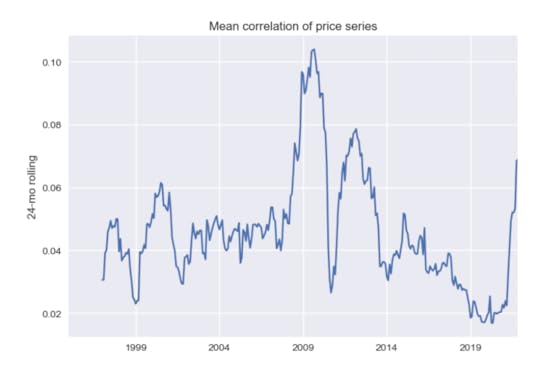
Clearly it shows a correlated upward surge in prices since 2020. But does this imply a true common cause or rather a common bounce back after a common shock?
We went back and forth on this on twitter.
Hi @policytensor thanks for taking this so seriously. I note the dramatic decline in correlation up to 2020, followed by the sudden co-movement. Is there a way of picking out the bit that is co-movement as a result of COVID-shock v. more general inflationary processes? pic.twitter.com/kbTkAbSfIY
— Adam Tooze (@adam_tooze) January 5, 2022
Forty centuries of price controls
Agree or not, the historical examples are great.
The delusion that governments can successfully manipulate prices has spanned cultures, nations and epochs.
— Peter Young (@petermiyoung) December 7, 2020
Inspired by Scheuttinger & @eamonnbutler's excellent book "Forty Centuries of Wage & Price Controls", I have catalogued my top 8 historical price control blunders.pic.twitter.com/RX7unUUyyW
And here is the thread by way of a thread reader app.
*****
I love putting out Chartbook for free to a wide and diverse range of subscribers from all over the world. It is a pleasure to write and a great place to pull ideas together. It is also, however, a lot of work. If you feel moved to support the project, there are three subscription options:
The annual subscription: $50 annuallyThe standard monthly subscription: $5 monthly – which gives you a bit more flexibility.Founders club:$ 120 annually, or another amount at your discretion – for those who really love Chartbook Newsletter, or read it in a professional setting in which you regularly pay for subscriptions, please consider signing up for the Founders Club.January 3, 2022
Chartbook #65: Inflation & Price Controls
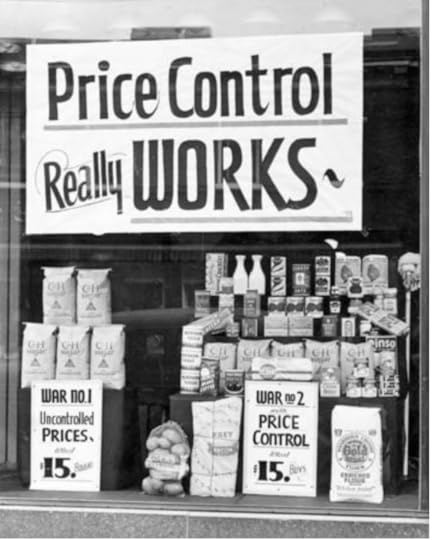
“We have a powerful weapon to fight inflation: price controls. It’s time we consider it.”
Last week, Isabella Weber’s op-ed in the Guardian, which – on the basis of positions taken by prominent American economists in 1946 – advocates “strategic price controls” as a means to controlling profit margins and inflation, has caused quite a storm.
I’m late to the game having been on a break from social media visiting in-laws in rural Kentucky.
Coming back to twitter this week, the ugliness of the reaction to Weber’s op-ed is depressing. Perhaps one should not be surprised. But it is depressing and telling, nevertheless.
I would much prefer to discuss the substance of the issues and I will do so below. But one should not pass over the tone of this debate without comment.
When it comes to the politics of intellectual life, I’m committed to showing not telling. Chartbook is part of that effort. But given the importance of the subject matter and since my name was invoked in one widely quoted thread, forgive me for making an exception in this case.
In this kind of debate there should be no room for disrespect. Full stop. However wrong and ill-judged you may feel Weber’s op-ed to be, there should be no room for disrespect. It was good to see Paul Krugman apologizing. But the harm was done.
This is not merely a matter of etiquette, manners, or personalities. In the tone of a debate, issues of professional authority are at stake. If the personal is political, so too is the tone of a debate.
Regrettably, the aggression triggered by Weber’s op-ed is also profoundly unproductive in intellectual terms. It turned what should be a serious argument about an important issue – the means of inflation-control – into an ugly slanging match. This is not by accident. One way to shut down an unwelcome discussion is by means of fist-pounding. Another is the tantrum. In either case, the unproductiveness of the ensuing conversation is not a bug. It’s a feature.
***
Weber’s op-ed is short on substance. She does not tell us what kind of price controls she advocates, on what sectors etc. But, in fairness, the op-ed links to work that is more specific.
If you are serious about engaging in the argument, don’t focus on Weber’s 800 word squib, read it in light of her important historical work on price control politics in the West and China after 1945, which poses its own questions. And acknowledge the fact that her suggestion is not without context. It reflects a rich vein of recent post-Keynesian writing that has urged “unconventional” approaches to inflation control.
I say post-Keynesian deliberately. Tilting at MMT was another of the distractions of the price control debate on twitter.
What can we salvage from the wreckage? How can we take this debate in a more productive direction?
As Eric Levitz makes clear in his excellent write-up of the debate, whether you find Weber’s op-ed convincing or not, there is a serious position to be argued with. The effort to assert the monopoly of conventional inflation-fighting disarms us.
One could make a strong case for more stringent controls throughout the American health-care system. And price controls are themselves just one of many unorthodox approaches to inflation management. Reducing the monopoly power of price-gouging firms, channeling credit to sectors where demand outstrips supply, forcing (or strongly encouraging) workers to save a fraction of their paychecks, and direct public investment in expanded production are others.
All of these measures have the potential for negative side effects and unintended consequences. But the same can be said of raising interest rates. If policymakers reflexively presume the wisdom of conventional tools, and dismiss the potential of unorthodox ones, we will all pay the price.
On the history of price controls in the US since 1945, follow the excellent Andrew Elrod, whose PhD is going to make a major impact. Start with this thread.
Exasperating to see price controls hitting such a raw nerve in real time over the past few days on here. Guess the Cold War isn't over after all!
— Andrew Elrod (@andrewelrod) January 2, 2022
It includes this great line: “Informed debate then was never about whether prices should be controlled but who should control them.”
For a serious discussion of how price controls have actually operated in the US up to the present, check out this piece by Todd Tucker.
For post-Keynesian proposals on how regulations and price controls of various types might assist in managing America’s current inflation problems, check out the position of Josh Mason and Lauren Melodia at the Roosevelt Institute.
Having said all that, I remain unpersuaded that price controls can be an important remedy in our current situation.
***
Some are skeptical because they believe that inflationary pressure is broad-based and merits a monetary policy response.
For my part, I’m a paid-up member of team transitory, a diagnosis Weber mentions but does not seriously address. In fact, I am not just part of team transitory. I am a member of team sectoral, as well. To put a point on it, I am not convinced that the current round of price increases should really be thought of as a general inflation at all. I am impressed by recent BIS work which shows the common factor in recent price movements declining in significance. And if that is true for data up to 2019, it is all the more the case for the period since the COVID shock. Matt Klein’s breakdown of the data into COVID and non-COVID elements is highly persuasive on this score.
If one takes this approach, the question becomes which instruments might usefully address which drivers of which price increases. It is not obvious to me that either interest rate hikes or price controls in general can be of much help.
Weber starts by stressing rising profit margins as an important driver of general inflation. On that score I find the critique by BLS-financial analyst and Substacker Joseph Politano wholly persuasive. It just isn’t likely that a general surge in profit margins is doing the damage here.
Likewise, I find Politano’s breakdown of the sectoral logic of inflation highly persuasive as well as his skepticism towards price controls as a means of addressing inflation in energy prices, for instance.
There is no doubt a case for driving down the price of pharmaceuticals in the US. Rent controls may be part of housing-policy trade-off in some cities. The meat lobby has an anti-trust case to answer. But I see little advantage in packing an array of discrete measures using existing instruments under the (deliberately) provocative rubric of “price controls”.
I don’t think it is pejorative to describe the use of the term “price controls” as provocative. I take it to be the purpose of this language to provoke debate and break open the confines of conventional discourse.
But as desirable as that kind of heterodox challenge may be in general terms, we will be kidding ourselves if we imagine that such measures are a “powerful weapon” to fight the spike in prices in 2022.
Cleaving to team transitory does not imply complacency. It just implies that faced with a range of bad options we should practice restraint in adopting any anti-inflationary policy, whether that involves monetary policy, regulatory policy or fiscal policy.
***
One of more striking set of data to appear of late are the quarterly numbers for fiscal impact produced by Brookings. For all the talk of Biden stimulus, the fiscal impulse went into negative territory in Q2 2021. Even on a four-quarter moving average basis it is now on the border of negative territory.
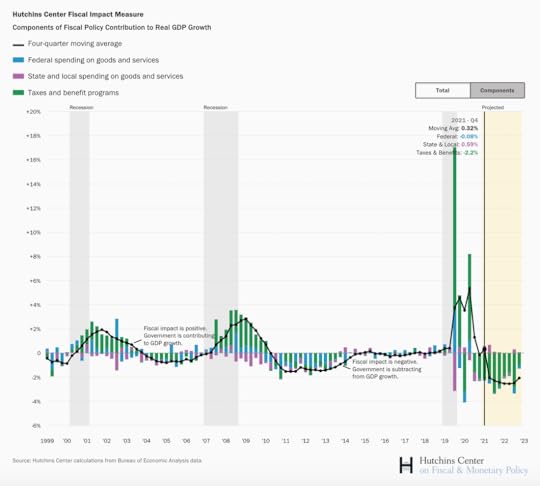
Source: Brookings
For more on the impact of Biden’s fiscal policy and the Rescue Plan in particular, check out this excellent piece by the EPI.
Though I would take issue with the language Weber uses to characterize the team transitory position – “houses on fire” etc – no one would deny that there are political risks involved in the current price surge. The Biden team clearly think it is important to be seen to be doing something about the price of petrol, meat etc.
But what purpose is served by labeling this as a policy of “price controls” and harking back to the 1940s?
On purely intellectual grounds a more wide-ranging debate is no doubt to be welcomed. But we are not in a debating club. This is the arena of high-stakes politics. What matters for the Biden administration are the midterms in 2022. Has anyone done any polling on how talk of “price controls” might play with important swing constituencies and media outlets that make a difference?
On drug prices, a large majority of Americans seem to favor robust drug price negotiations. But when the issue of price control is raised, at least one yougov poll (take it or leave it) shows little enthusiasm (and yes I am aware of the website this is published on).
Happy to be corrected on this, but perhaps an activist, tough government negotiator is more attractive than the bureaucratic visions summoned up by talk of “price control”. Certainly, the experience of 1940s control cast a long shadow over American public debate of the issue of price controls for decades to come.
Which brings us finally to the uses of history.
***
Some folks in the progressive camp are clearly convinced that taking inspiration from history, not just from the general aura of the New Deal, or from specific policies, but even from policies, like peacetime price controls, that were debated in 1946 but not implemented, is intellectually productive and politically helpful. I’ve been a skeptic on this “blast from the past”-strategy since the Green New Deal came on the scene. I find it hard to see how progressive politics benefits from this kind of historicism. As far as the Green New Deal is concerned I have come around. I’ve ended up embracing its grand vision of our historic predicament, whilst continuing to worry about strong analogies being drawn between the mid-century moment and our current situation. On those grounds I find Weber’s effort to segue from 1946 to 2022 unpersuasive.
Obviously, I share her interest in history and I share the enthusiasm for the writings of mid-century macroeconomists like Keynes, Kalecki, Lerner et al. But I am deeply skeptical when it comes to teleporting structural analyses and particular policy lessons from the mid 20th century into the present. And we should particularly guard against the kind of nostalgia that is evoked by the evocation of “If only, …..”.
In another domain of history and policy one might refer to this as the “Lost Victories” syndrome.
Precisely because the dynamic of modern history is so dramatic and so violent, because the pace at which complexity increases is so staggering, because the kaleidoscope of power and political economy shifts so radically, I don’t think that history’s role should be to invite us to refight past battles.
Nor is development all in one direction. It is far from obvious that the US government machine today would be able to mobilize the competence and resources necessary to supervise prices on a large scale. Recent experience with the provision of basic services like COVID testing hardly suggests as much. Rebuilding administrative competence may in fact be part of the underlying project of market supervision and price control. But in that case it is a long-haul strategy.
Of course, history functions in non-linear ways and it is not per se inconceivable that a “blast from the past ”, “lost cause”, “if only…”-strategy may work as a political proposition. What else did Donald Trump trade on? But it is a gamble at long odds and on any conventional understanding of progressive politics a leap back to a golden age that might have been hardly seems like an obvious move.
Faced with the drama of the great acceleration – the dramatic escalation of modern history – the more obvious role for history would seem to be to help us to understand how we got here.
Of course, Weber’s leap into the past is not unmotivated. In fact, it is warranted by no lesser authority than the White House Council of Economic Advisors. In July 2021 the formidable team of Cecilia Rouse, Jeffery Zhang, and Ernie Tedeschi issued a paper giving quasi official endorsement to the aftermath of World War II as the proper historical analogue for the present. I don’t know whether this is a historic first – for. the White House to announce its preferred historical analogue. But it is certainly a remarkable example of the instrumentalization of history.
The aim was clear. To cut off the alarming analogy to 1970s-style stagflation. As the authors conclude:
No single historical episode is a perfect template for current events. But when looking for historical parallels, it is useful to concentrate on inflationary episodes that contained supply chain disruptions and a spike in consumer demand after a period of temporary suppression. The inflationary period after World War II is likely a better comparison for the current economic situation than the 1970s and suggests that inflation could quickly decline once supply chains are fully online and pent-up demand levels off.
It is this prise de position by the Biden administration’s advisors that licenses Weber to make her move: “Well, if you want to talk about the aftermath of World War II, let us talk about price controls and the policy that was advocated at the time by many distinguished economists …”.
Thus a leap back in time by way of analogy licenses a “sideways” leap into counterfactual, along the lines of: “If only back in 1946 they had listened to Samuelson et al … Let us not repeat their mistake. Let us not shy away from what was advocated by the best and the brightest in 1946”. The dialectic of progress seems to be envisioned not so much as avoiding mistakes, but avoiding omissions of the past, missed opportunities etc.
But if you want to talk about the historical experience with price controls in America since World War II can we really do so seriously without engaging with the embattled history of those instruments when they were actually last tried in practice on a large scale? Don’t you have to engage with the historical terrain that the White House team were trying to avoid, i.e. the 1970s?
Like it or not, that is how we got here. That is the epoch that left folks like Krugman as conflicted and allergic as they clearly feel about any mention of price controls.
I am all for a creative historical reimagining of the 1970s. Releasing us from the nightmare memories of that period would do a great service to the political imagination. But price controls seem a particularly unpromising territory, particularly given the area of price inflation that mattered most, then and now i.e. energy.
If energy prices have been the largest single driver of the price spike since 2020 not just in the US but around the world, would anyone wish to repeat America’s experience with energy price controls in the 1970s? Surely not. Bullying OPEC has its attractions – think of it as the analogue to muscular negotiations over drug prices – but it also harbors risks. Not only does it promote greater oil production, which is the opposite of what we need, but it entrenches the popular sense that low energy prices are an American birth-right that is the job of government to deliver, by all means necessary.
***
By a process of elimination, the best judgement is surely what it was last autumn. If “team transitory” favored patience with regard to monetary policy that goes double for any policy of “strategic price control”.
The Biden administration has little to gain and much to lose by dramatizing the situation. By all means, go for the easy wins. So long as they do not deflect from strategic objectives like decarbonization. Pick off the profiteers. Use the tools that are available. But let us not confuse our situation today with that facing the United States after World War II. We are far removed from that epoch, both from its dangers and its possibilities. We have our own problems to face, let us address them on their own terms rather than rummaging in the locker of the mid twentieth century.
***
I love putting out Chartbook for free to a wide and diverse range of subscribers from all over the world. It is a pleasure to write and a great place to pull ideas together. It is also, however, a lot of work. If you feel moved to support the project, there are three subscription options:
The annual subscription: $50 annuallyThe standard monthly subscription: $5 monthly – which gives you a bit more flexibility.Founders club:$ 120 annually, or another amount at your discretion – for those who really love Chartbook Newsletter, or read it in a professional setting in which you regularly pay for subscriptions, please consider signing up for the Founders Club.December 28, 2021
Chartbook #64: Energy crisis 2021 – the China shock
Like it or not, we live under the shadow of China. First there was the “China shock” to labour markets which has – whatever its actual size – become a cause célèbre in the US. Then there was the fear of a Chinese financial attack – the idea of a balance of financial terror between the US and China. In 2008 that failed to materialize. In 2015 the tremors of the Shanghai meltdown were felt around the world. That has come back to haunt us in 2021 with the Evergrande crisis. Since 2020 we have been battling with COVID – contagion from China in the literal sense. In 2021 America’s military leaders had their “almost Sputnik” moment with the news of China’s hypersonic tests. Finally, in the second half of 2021 Europe has been reeling from a shock to energy markets which originated in China.
China’s dramatic recovery from the COVID shock and the inability of energy supplies to keep up, has delivered a dramatic jolt to global gas prices. As far as Europe is concerned, it is the most severe energy price shock since the 1970s.
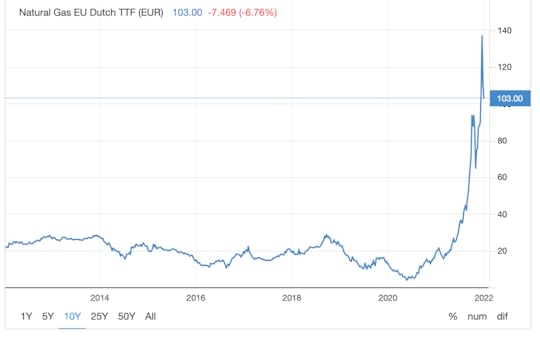
Source: Trading Economics
In Europe the supply pressures are so intense that nuclear-reliant France has resorted to burning oil to keep the lights on.
The energy price hike has triggered a series of debates about the future of the energy system, the impact of the green transition etc. I was involved in exchanges with Richard Seymour and Cédirc Durand and others. In this post I want to go back to the beginning.
This starts with China and it starts with coal. It is by way of coal that we get to gas and, by way of gas, we get to Europe.
***
To be precise (correcting and amplifying a briefer treatment in Chartbook #51), the story starts not with supply shortages, but with a huge surge in energy demand.
As energy consultant Wood Mackenzie reported in awe: “China’s economic growth at over 8% in 2021 fired up soaring power demand: China’s electricity consumption grew by 10%, which was the fastest annual growth for any major economy in the recorded history of the industry.”
Not only electricity generation but steelmaking and cement all came on stream in force in early 2021 driving up energy and coal demand. Any supply system would have had a hard time keeping up with such a rebound. China’s could not. The IEA’s Coal Report for 2021, released in December gives a blow by blow account.
It starts by setting the scene in suitably grand style:
Power generation in China alone is responsible for almost one-third of global coal consumption. No other sector in any other country – or any other fuel – has a comparable influence on global trends.
Unlike in the rest of the world on account of its rapid recovery from COVID, power demand in China rose even in 2020 by 2.2%. That was less than the trend 3.9% per annum growth, but already over the winter of 2020-21 difficulties were apparent.
An unusually cold winter further increased electricity and heat demand. A large share of China’s coal-fired power capacity is co-generation (combined heat and power production) … Therefore, as demand spiked to meet higher-than-usual heating needs in December 2020, China was confronted with power shortages due to inadequate capacity in at least five regions.
Then in the summer a heatwave intensified cooling demand at the same time as low rainfall amounts reduced hydropower generation. By the third quarter of 2021 a severe imbalance had emerged between coal supply and demand with order books for coal mines lengthening alarmingly.
Why could China’s coal production not keep up? Did environmental concerns, and specifically climate policy, contribute to the inelasticity of supply?
The short answer is that China’s giant coal industry is undergoing restructuring. The reshuffling of production from small to large mines and between regions is dramatic. Environmental concerns are a major issue for the governance of the sector and in the 14th Five-Year Plan, climate is a concern too. But to the chagrin of climate campaigners everywhere, we are far from the point at which climate is the chief regulating factor in China’s coal production (energy demand, as we shall see, is another story). As the IEA summarizes the situation:
“Under China’s 13th Five-Year Plan (2015-2020), about 5 500 coal mines with a total production capacity of ~1 000 Mtpa were closed, reducing the total number of mines to 4 700. New modern, large-scale opencast and underground mines are being approved to replace this capacity, mostly in the main coal mining regions of Inner Mongolia, Shaanxi, Shanxi and Xinjiang. In 2020, coal production increased 1.1% to a new high of 3 764 Mt, surpassing the previous record set in 2013. Although the Covid-19 pandemic disrupted China’s coal production in the first quarter of 2020 (despite a production capacity expansion), it has been climbing since the second quarter.”
The 14th Five-Year Plan, which outlines China’s economic priorities for development during 2021-2025, attempts to balance environmental (i.e. climate), energy security and affordability considerations. Therefore, despite China’s commitment to peak its carbon emissions by 2030 and achieve carbon neutrality by 2060, the plan considers coal an irreplaceable energy source in upcoming years. The plan’s aim is to stabilise coal production to secure 4 100 Mt by 2025.7 … Following the direction already charted by the 13th Five-Year Plan, Chinese mining companies are to make their mines increasingly safe, automated and digitalised, as per the “large-scale, modernisation, intensification and ecology” development directive. As part of this process, China’s total number of mines is to be reduced by 700 to 4 000, meaning that small mines will continue to be closed. The government of Shanxi, currently the largest coal-producing province, has already announced a production cap of 1 000 Mt per year. Meanwhile, production increases are planned for Inner Mongolia’s Shendong Coal Basin, and for mines in Shaanxi and Xinjiang. Total coal production of 3 982 Mt is forecast for 2024.
As the IEA coyly notes: “we do not expect (unabated) coal consumption and production to be on the Net Zero by 2050 pathway by 2024.”
Inner Mongolia is favored because it offers the prospect of developing gigantic opencast mines.
The problem in 2021 was not so much the inadequate size of the coal mining capacity in China, as the sudden surge in demand and a series of specific supply difficulties impacting the main four producing regions in China.
Starting in 2020, Inner Mongolia’s coal supply growth was hampered by an anti-corruption probe that strengthened control of mine production for approved capacities. Safety and environmental regulations also became stricter throughout the country and punishments for failing to comply with safety guidelines were increased. These factors, together with natural disasters such as floods, disrupted China’s coal production and logistics in 2021 …
… thermal coal production decreased and coal transports to coastal provinces were delayed by heavy rainfalls and flooding in North China in July, August and October 2021. Furthermore, following a series of accidents, safety regulations were tightened and mining operations were interrupted more frequently for safety reasons….
… In October, flooding in Shanxi forced mines to shut down and made the supply situation even worse just as northeastern China’s heating season was beginning.
One relief valve for China’s stressed coal supplies could have been imports. But Beijing pursues a deliberate policy of throttling the import of coal. China sets an annual import quota, which is a carefully kept secret. This restriction of imports has resulted in a spread between higher domestic coal prices in China and lower prices available on global markets.
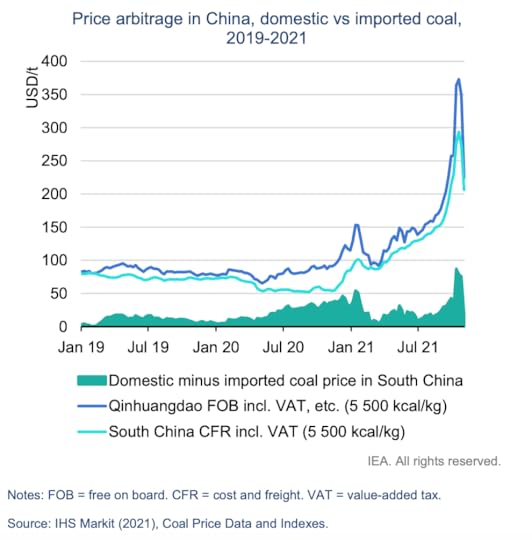
… In January 2021, the price spread jumped to USD 54/t due to high domestic coal demand for power generation as well as heating during an exceptionally cold winter in China. Shortly afterwards, however, the domestic coal price fell sharply and the price spread shrank to USD 4/t as demand decreased with milder temperatures and the Chinese New Year holidays in February. In the second quarter of 2021, both Chinese domestic and international coal prices rose again, and in mid-October the price spread spiked at USD 87/t, a relative premium of about 30%. This price spread signals arbitrage opportunities for Chinese traders, but they were not able to exploit them due to China’s import restrictions.
In 2021 even if China had wanted to source a large volume of imports, global supplies were restricted, not by strategic climate policy, but, once again, by a variety of short-term factors.
Coking coal imports from Mongolia, already low due to pandemic containment measures, were suspended for a week in August after several truck drivers tested positive for Covid-19. Plus, Chinese ports require foreign ships to quarantine for 7 to 21 days, and some ports have also been partially or fully shut down, delaying ship loading and unloading and raising coal freight rates in Asia. Indonesian coal exporters have not been able to fill China’s supply gap. Heavy rainfalls in the coal-rich regions of Kalimantan and Sumatra constrained coal production in 2021 and even forced several producers to declare force majeure in the third quarter of the year. Low heavy-equipment availability also limited the ramping up of coal production, so to secure the country’s own domestic supply, Indonesian authorities called for compliance of domestic market obligations for more than 30 mining companies to limit coal exports. This intensified supply scarcity in East Asian seaborne coal markets and drove prices up in August and September 2021.
The IEA has mapped outages and disruptions to global coal supplies. It was a perfect storm.
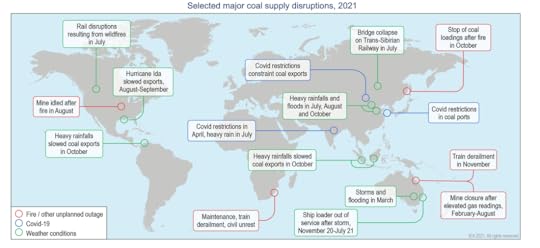
Back in China, as coal prices surged, in a well-functioning market, electricity generators would have passed those price increases on to consumers, raising the profit margins of generators, thus encouraging extra capacity to come on line, and throttling unnecessary demand. But China’s giant electricity market (like that of India) is only partially liberalized. As Caixin reports:
Although China has launched several rounds of restructuring to liberalize the power market since 2015, only 30% of electricity supplies are priced by market forces, the rest being under government control …. (end-user electricity prices are fixed and may fluctuate by no more than 10 percent.) … In Guangdong, a power plant staffer said generators were selling below cost when the coal price reached 1,400 yuan per ton. Thermal coal prices in the Guangzhou port hit 1,550 yuan a ton on Sept. 24, up 310% from a year earlier. Squeezed by rising costs, several leading power generators in August sent a joint letter to the Beijing Municipal Commission of urban management asking for higher prices on electricity purchase contracts for the fourth quarter. The companies said almost all coal-fired power plants were suffering losses. But signs of change have emerged as several provinces, including Shanghai, Shandong and Guangdong, have allowed greater fluctuation in local power pricing.
Given the seriousness of the energy supply situation, Beijing might have resorted to emergency liberalization measures, but it was more concerned with inflation so the price caps remained in place. The net effect is that unconstrained demand met reluctant supply. This generates headlines about an “energy crisis”. Fingers are pointed at the coal mines, but the problem is not in coal supply but in the power market. Lauri Myllyvirta gives a particularly penetrating account of China’s energy market failure in this piece in Foreign Policy. As he makes clear, it was not environmental concerns, but perverse incentives that created the electricity supply crisis. It was not until October that Beijing permitted a general liberalization of electricity prices, which brought generators back on line.
In the short-term, the immediate response of the the authorities was to ration power supply.
In mid-2021, China began to curtail industrial activity in some provinces as coal supplies and imports were unable to keep up with demand. In September, power rationing for industrial consumers occurred in 20 provinces. In Guangdong province, for example, manufacturers of ceramic products experienced power cuts of up to 70%, and Yunnan province ordered cement producers to cut production by 80%. Similar measures – and even complete power cuts – affected aluminium, steel and other energy-intensive industries all over China. In Heilongjiang, Jilin and Liaoning, even residential consumers were affected as power supplies fell short of demand by as much as 20% at times.
It was at this point that climate concerns entered into the picture, not on the supply but on the demand side. To begin limiting emissions Beijing has decreed targets for energy consumption and energy intensity – the policy of so-called “dual control”. As regions exceed their targets they are red-flagged and at that point they begin to cut off industrial consumers who have exceeded their quota.
By halfway through the year, ten provinces – accounting for around 40% of China’s GDP – had reached the “red” warning level for either energy intensity or energy consumption. The red level is a first-level warning when implementation is more than 10% off the target. The yellow level indicates that implementation is below the target, but lower than 10%. Towards the end of the third quarter (end September), some provincial governments were forced to mandate power cuts to energy-intensive industries to achieve their quarterly targets.
In this way, climate policy considerations enter the picture of the Chinese energy crisis. But whether one can really call this a crisis or even a dilemma, as some authors have suggested, is debatable. China has a target for energy consumption and it is imposing it. The crisis is not at the level of policy. The policy’s objectives are being met. The crisis arises at the level of the firms that find themselves without power and realize, abruptly, that their business model is not viable. That in turn creates a dilemma in the form of laid off workers and paused production.
All told, by September two thirds of provinces in China were under one or other form of energy rationing, whether due to excess demand or inadequate supply.
The resolution in the short-run was for Beijing to drive up coal production.
To ease the supply shortage, the Chinese government has asked regional authorities and coal mining companies to boost coal production. At the same time, the National Development and Reform Commission (NDRC) has called on major producers to cap prices on a voluntary basis (rail availability will be limited for producers pricing above the cap) … authorities in Inner Mongolia approved the restart of 38 disused opencast mines with a capacity of 66.7 Mtpa, and the NDRC has eased conditions for mine extensions taking place before April 2022. In addition, Shanxi province ordered its 98 coal mines to increase their annual output by 55.3 Mt over the remainder of the year and allowed 51 coal mines that had reached their annual production cap to keep producing and raise capacity, adding roughly 20 Mt of extra supply.
In the long-run the answer is greater efficiency, decarbonization, or structural change.
In 2021 the headlines were grabbed by the crisis at Evergrande and Beijing’s policy of deliberately deflating the real estate bubble. As far as the energy and emissions questions are concerned, this is crucial. The IEA reports: “China’s steel and cement production declined considerably. In September 2021, cement production was 13% below the 2019 level and steel production was 21% lower.” A shift away from the construction-driven, heavy industrial growth model is clearly essential if China is to achieve its decarbonization goals. Again, Lauri Myllyvirta is a crucial follow on this. Read his report on the downturn in China’s real estate sector and its impact on emissions.
As Caixin’s reporting makes clear, the structural adjustment is wide-ranging.
In late September, Zhejiang’s energy bureau said the province is determined to replace some energy-intensive industries with new businesses. The eight industries with the greatest demands for energy, including textile and dyeing, account for 43% of the province’s power consumption but contribute only 13% of economic output, according to the bureau. Zhejiang’s textile manufacturers enjoyed a spike in overseas orders this year as production remained largely halted in India and Southeast Asia because of the pandemic. Many companies quickly expanded production capacity to accommodate the rising orders, one industry expert said. But profit margins in the industry have become thinner, squeezed by soaring material and shipping costs. …. With high energy consumption and little profit margin, China’s competitive edge in textiles will keep shrinking, and the industry will continue relocating to Southeast Asia, said Wu Xinyang, an analyst at CSC Financial. China’s energy-control ambitions will also affect its steel industry, the world’s largest in terms of output since 1996. According to China International Capital Corp., the 19 provinces blacklisted by the NDRC for failing to fulfill energy-control targets account for 53% of the country’s total steel output. In Jiangsu, steel mills were hit by the toughest production-halt orders in September. A company executive told Caixin that his plant was ordered to suspend operations on Sept. 11 for more than two weeks. “I’ve never seen a production halt last for so long,” the executive said. He predicted that more such orders may come in October. A manager at the Anshan Iron and Steel Group in Liaoning said the production restrictions will force steel companies to shift to more-advanced products … Although China has remained the world’s largest steel producer for more than two decades, it still relies on imports for some highly sophisticated steel products. Under the pressure of energy targets and capacity cuts, China’s raw steel output declined 13.2% in August to 83.2 million tons. The central government has taken moves to force local economic transformation. Since June, it has turned down several local authorities’ proposals to build new facilities with high energy demand, including a 126 billion yuan coal chemical project in the northwest province of Shaanxi, which was supposed to the largest of its kind in the world.
All told these adjustments have been enough to end the acute phase of the energy crisis in China. By November, energy rationing was easing. But this action was not enough to prevent spillover from China’s energy crunch to global markets. The most important of these is gas. In 2021 it was through the gas market that the imbalance of demand and supply for energy in China spilled over to world markets.
***
Unlike oil, given the difficulty of transport, the global integration of gas markets is only partial. Despite the effort to expand gas exports in the form of LNG, the US gas market is still largely insulated from that in the rest of the world. LNG accounts for only 10 percent of production. As a result America’s gas market remained largely insulated from the China shock. Unlike for oil there is not “one big market” for global gas.
Global discrepancy in benchmark LNG prices
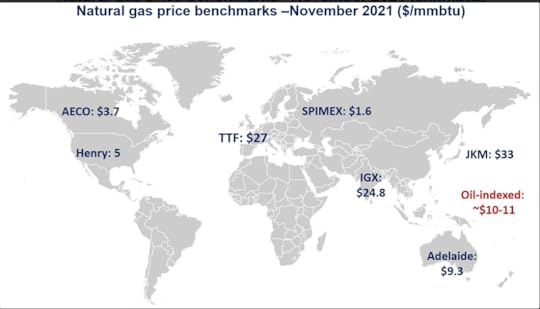
Source: Global LNG Hub
The globally traded LNG market has long been dominated by Asia. Japan, unable to import gas by pipeline, pioneered the LNG market. The first LNG shipment to Japan arrived in November 1969 on the Polar Alaska.
Today, China is increasingly driving the gas market.
Gas has moved to the center of China’s energy strategy as it contemplates the transition away from coal. In 2020 gas-fired power generation accounted for only 3.5% of China’s electricity supply. There is, thus, huge scope for growth.
As Wood Mackenzie reports: “The national oil companies (NOCs) have discovered 6.85 trillion cubic metres of natural gas resources in the past decade, 45% of total incremental resources since the founding of the People’s Republic of China.”
Historically, gas use in China has been dominated by the the industrial sector (as fuel and feedstock), with the industrial share of consumption at 50% of the market. But coal-to-gas switching in power generation is shifting the balance. “Residential, commercial and space heating (RCH) demand is fast catching up. Coal-to-gas switching in RCH has already magnified China’s winter demand peaks. The trends of urbanisation, higher affordability, gas distributors building new city gas projects and winter clean heating requirements will provide gas access to a broader population.”
To reduce pollution particularly around Beijing, China pushed a campaign in 2017-8 to convert millions of homes from coal to gas heating. The result was a sudden shortage in gas supplies and LNG bottlenecks. Undeterred, in October 2020, China launched a new high-profile campaign to shift 7 million households from coal to gas heating over the winter of 2020-2021.
In 2021, China’s demand for gas surged even more dramatically than that for coal. “In H1 2021, China’s gas demand saw a 16% year-on-year increase, led by strong power and industrial demand. Underperforming hydropower in southwest China, tight coal supply coupled with high coal prices across the country, and high summer temperatures supported gas-fired power generation. Export-led economic growth and domestic consumption recovery benefited overall energy demand, including natural gas. … To meet its rising demand, China has been boosting domestic production of natural gas, debottle-necking infrastructure, diversifying import sources and introducing market-oriented reforms.”
Unusually, China’s LNG imports rose in Q2 2021, normally a slow period for global markets.
In 2020, China was already the world’s largest gas importer. In 2020 it imported 48 billion cubic meters through pipelines and 93 billion cubic meters in the form of LNG (67 million tonnes (Mt)). In the first half of 2021 China overtook Japan as the world’s largest LNG importer.
LNG has certain key advantages for China. Until piped gas storage capacity is expanded, LNG is more flexible than pipeline gas and it is particularly attractive in Southern China, which is far from the main onshore gas-producing basins.
To meet this demand, investment has been gigantic. In China the gas infrastructure is taking shape:
A crucial landmark was the establishment of China Oil & Gas Pipeline Network Corporation (PipeChina) in December 2019. The new national pipeline company will be responsible for the development and management of transportation of gas, crude oil, refined products plus re-gasification and underground gas storage. PipeChina will consolidate a large part of midstream assets held by the three national oil companies (NOCs), which have started to swap some assets. It will operate the infrastructure assets as an independent business and will provide efficient third-party access, facilitating market access to suppliers and end consumers.
The problem is that lead times are long. LNG and other gas projects are very complex. Investment in storage capacity in Asia is even more inadequate than in Europe. As a result, supply capacity was not sufficient to meet the sudden demand spike in 2021. Prices surged.
Whilst US natural gas prices languished in Asia gas prices surged to historic highs. European gas prices followed. By December Asia was so glutted with LNG and Europe was so desperate, that cargos were being diverted en route and Asian buyers considered re-exporting their LNG to Europe. Europe’s energy future has come to hang on how cold the winter weather will be in Asia.
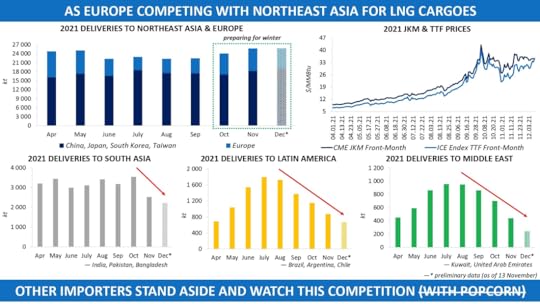
Source: Global LNG Hub
For more than a decade, Europe has been relying on imports of cheap gas, whether by pipeline or in the form of LNG priced at spot rates. It has been a buyer’s market. Apparently no one considered the possibility that the global pattern of demand might be about to shift. No one considered the need to build adequate stocks of gas. In 2021 the tables turned. The China gas shock arrived.
***
The 2021 energy price shock is not primarily a story about inadequate supply. It is the story of a huge demand surge and a breakdown in China’s ramshackle electricity markets. Throwing government mandated shutdowns into the same pot as energy supply problems triggered by faulty electricity pricing, attributing either to inadequate supplies of coal, or the overshadowing of the coal sector by decarbonization, simply muddies the water.
But what is clear is that China’s energy system is the whale in the global energy economy. It is the dominant factor in the emissions equation as well. As its shifts balance away from coal that will affect other energy consumers all around the world, above all consumers of gas. As Europe is learning, if you rely on the global gas market, you are relying on a market increasingly driven by Chinese demand.
It is not even obvious, in fact, what role gas will play in China’s energy transition. The uncertainty of supply over recent years, gives Beijing reason for caution. Coal dominates the equation and renewables may expand so rapidly that gas never plays the central role that it does in Europe and the US today. Given the speed with which transition must be accomplished, the idea of gas as a transition fuel may prove a snare. China’s official documents are hard for outsiders to read and a debate is ongoing within China itself.
But the point is that even with gas accounting for a small part of China’s energy mix, even with coal as its mainstay, China’s development has huge implications for the rest of the world. If that is what we mean by an energy dilemma, then there is certainly a dilemma. Except, of course, that a dilemma implies a tough choice and with regard to energy policy that is hardly the case. Both China and Europe need to force investment in renewables and the development of storage technology at the fastest rate possible. That is win-win. It creates jobs. It will generate profit. It increases resilience. It reduces dependence on fickle global markets. The problem is not inadequate investment in fossil fuels, the problem is inadequate investment in the alternatives.
***
I love putting out Chartbook for free to a wide and diverse range of subscribers from all over the world. It is a pleasure to write and a great place to pull ideas together. It is also, however, a lot of work. If you feel moved to support the project, there are three subscription options:
The annual subscription: $50 annuallyThe standard monthly subscription: $5 monthly – which gives you a bit more flexibility.Founders club:$ 120 annually, or another amount at your discretion – for those who really love Chartbook Newsletter, or read it in a professional setting in which you regularly pay for subscriptions, please consider signing up for the Founders Club.December 24, 2021
Ones & Tooze – From the Archive: How Inflation Works
Season 1, Ep. 14
When we first aired this episode of Ones and Tooze on why prices are rising, analysts were warning of a possible inflation crisis. Now, two months later, the crisis is here, with inflation at a four-decade high. Listen to hosts Cameron Abadi and Adam Tooze discuss how inflation works and what it means for ordinary people around the world.
Also on the show: what Germany’s increasing demand for Italian pasta says about the European Union economy.
This is our last episode of 2021, so happy new year! We’ll be back in January.
For more on the podcast visit the Ones & Tooze page at Foreign Policy
Chartbook #63: Turkey’s financial crisis
Earlier this week, Mohamed El-Erian was lost for words. As he wrote in the FT:
It is hard to put into words how disorderly the Turkish currency markets had become by Monday afternoon. The lira had weakened to beyond TL18 per US dollar, constituting a halving of its value in just two months.
It was the low point in the staggering run on the Turkish Lira that began in earnest in September.
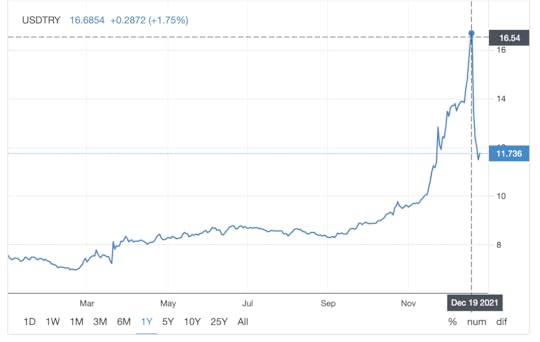
***
Turkey’s financial crisis has thrown into turmoil a country that is pivotal to the Eastern Mediterranean, Western Asia and forms the boundary between the Middle East and Europe.
In recent decades, Turkey with its population of 84 million has been hailed variously as a great success story, a future home of Muslim Democracy, a democratic backslider and quasi-authoritarian regime.
Its population and relative economic success gives Turkey heft. Erdogan’s government is a power political player in the Caucasus (backing Azerbaijan v. Armenia), Syria, Iraq and Libya, to name just the most obvious theaters of its foreign policy. It also holds the key to the European refugee situation.
In an import-dependent economy, the halving of the exchange rate in a matter of months delivers a dramatic shock, driving up the price of essentials and unleashing inflation. Inflation number themselves become the object of bitter argument.
According to Al-Monitor: “Turkey’s monthly consumer inflation is expected to hit a staggering 15% in December and bring the annual rate to at least 35%. The Turkish Statistical Institute (TUIK) is due to release the official figures Jan. 3.” But accessing the statistical agency can be difficult for opposition politicians.
Gates locked! Turkey statistics agency doesn’t allow main opp leader @kilicdarogluk in who wanted to pay a visit following the latest official inflation numbers (21.31% for Nov) which opp claims shd be much higher pic.twitter.com/2YriU0A2PY
— Selin Girit (@selingirit) December 3, 2021
On the other hand, Turks who support embattled President Erdogan celebrated the rebound of the lira against the dollar earlier in the week by demonstratively destroying the American currency.
Dolar kıyması yapan zihniyet… Bu cehaleti ancak Erdoğan yönlendirebiliyor. Geçmiş olsun hepimize… pic.twitter.com/fBi39XsSDN
— Maaz İbrahimoğlu (@maazibrahimoglu) December 22, 2021
Behind the scenes, billions in private deposits have shifted from the unstable Lira to foreign currency deposits. The government is now trying to tempt them back.
Those with funds to move are the lucky ones. Turkey is a middle-income country, millions of citizens scrape by at very low income levels. As Middle East Eye reports: “bread prices have shot up by 25 percent in the past month alone, creating long lines of people outside subsidised bakeries owned by local municipalities. Flour prices have jumped by 300 percent in a year, while other basic items such as milk and cheese have seen a 47 percent price rise due to increasing costs.”
***
Though the Turkish central bank is secretive about its interventions, it is clear that it has been trying to stem the collapse in the Lira by selling any dollars it can get it hands on. The result is a crazy escalation in the central bank balance sheet, as the bank borrows funds to pump into the markets.
The Turkish central bank doesn’t like doing this in public or in daylight, so it has taken to making unannounced interventions overnight. For those Turks who have bet the other way, on a continuing depreciation, the sudden reversal is itself a disaster.
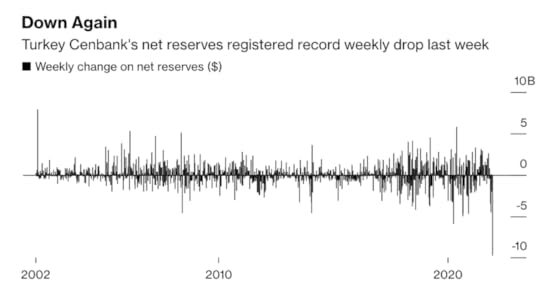
Source: Bloomberg
Once upon a time Brad Setser would have been filling us in on the movements in Turkey’s balance sheets. But Brad is now with US Treasury. In his stead, the brilliant Daniela Gabor has stepped up with this fantastic thread.
The one thing that the central bank is not doing is raising interest rates. This is at the heart of the entire crisis. President Erdogan does not like independent central bankers. In March 2021 he replaced Naci Ağbal who was installed in November 2020 in the midst of a previous wave of currency depreciation and was credited with pursuing a more orthodox course with Şahap Kavcıoğlu a former MP for Erdogan’s AKP.
On direct orders from President Erdogan, since August, the Turkish Central Bank has cut its policy rate by 500 basis points, from 19 percent to 14 percent. It is that remarkable decision, contrary to pressure in global markets and global economic opinion that has set the stage for the current crisis.
It is a remarkable escalation of Erdogan’s long-standing struggle with finance and capital markets. For older Turks, a crisis this severe awakens bitter memories of earlier historical moments. See this series of interviews by Middle East Eye.
Since the early 2000s Turkey has relied heavily on foreign borrowing (mainly by the private sector) to finance large current account deficits brought on by rapid growth. As Dani Rodrik told the FT:
Erdogan had ridden a wave of capital inflows that were attracted to Turkey by slightly higher interest rate margins. “One of the myths of financial globalisation is that it enforces macro[economic] discipline,” Rodrik said, suggesting that financial markets would ensure countries ran credible and sustainable policies that attracted foreign cash. “In Turkey, it was the opposite. Turkey’s economic experiment ran much longer than it should have, thanks to the more elastic supply of finance. The economic costs will be larger as a result.”
It is not the first time that Turkey has come under pressure. But the shock of 2021 is exceptional.
What is Erdogan’s game?
***
Erdogan has long cultivated an economic ideology that consists of a brew of convenient fragments of Muslim doctrine, productivism, hostility towards outside pressure. He is prone to associating any critics with external threats. As he made clear in recent weeks:
“Of course we know that price rises are causing problems in the daily lives of our people. Of course we are aware of the volatility in the exchange rate, the instability in prices and the uncertainty this creates,” he said. “But we will resist these just as we resisted tutelage, terrorist organisations, putschists and global power barons. I am telling you, there is no going back.” He attacked Tusiad, the country’s largest business association, which on Saturday urged the government to return to the “established rules of economic science” to restore stability and prevent further damage to business and the public. “Hey, Tusiad and your offspring,” he said. “I’m telling you, you have one job: investment, production, employment, growth . . . You cannot interfere in what we are doing.” The previous day, the head of Turkey’s Union of Chambers and Commodity Exchanges (TOBB), which represents small and medium-sized businesses and has in the past been supportive of Erdogan’s approach, warned that the financial turbulence was “worrying and negatively affecting many of our companies”. Rifat Hisarciklioglu, TOBB’s president, called on the government to take “urgent steps” to stabilise the markets and restore a more predictable environment for business. “Don’t expect anything else from me,” he said in a televised speech on Sunday night. “As a Muslim, I will continue to do whatever the religious decrees require,” he added, in a reference to prohibitions in Islam on usury.
Warring with Turkey’s secular business interests is now a key device through which Erdogan rallies his electoral troops.
He is egged on by advisors such as Cemil Ertem who systematically promotes the idea of politico-economic autonomy. Middle East Eye has gain accessed to a briefing paper prepared by Ertem, titled “The New Economic Model: Reasons and its Benefits” that may well be exerting a significant influence at this moment.
The main message given by Ertem’s presentation is economic independence. Over and over, he emphasises that it is impossible to be economically independent while carrying out a financial policy based on high interest rates or International Monetary Fund recommendations. Ertem asserts that a policy of high interest rates has triggered a vicious circle of low exports, lower employment, high imports, growing external debt and a country with an external dependence, which again requires higher interest rates, completing a full circle. “As a result, the country is posting a high current account deficit and depending on short-term hot money inflows and raising the external debt,” he says in the presentation. “This economic model, due to its external dependency, is laying [the] ground for economic attacks.” The chief economic adviser says his new model, based on lower interest rates, will increase exports and decrease imports, leading to a current account surplus and higher growth with high employment. He believes it will make Turkish exports more competitive with a depreciated lira. “We will incentivise foreign direct investments instead of short-term hot money inflows, and stabilise the foreign finances,” Ertem says. “And that’s how we will become a stronger country that is protected from the external financial shocks.”
If Erdogan were seriously introspective he would see that the growth model of recent decades that has sustained his own regime looks something like this one described by Özgür Orhangazi,A. Erinç Yeldan in Development and Change (2021).
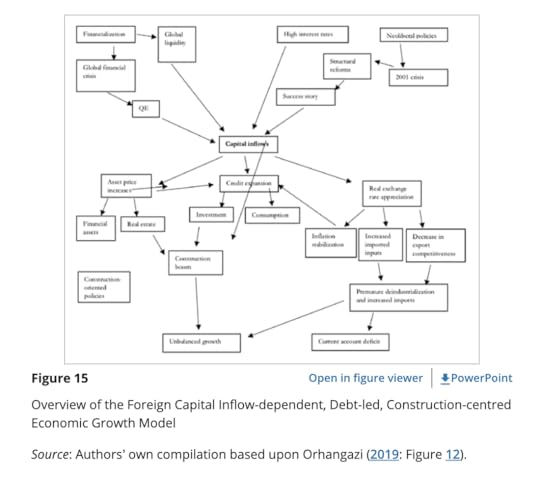
It does indeed systematically promote growth through construction rather than manufacturing, agriculture and exports. But rather than these structural elements, Ertem in his advice to Erdogan apparently stresses the political and geopolitical dimensions of dependence.
Providing examples of when the lira has depreciated previously – such as during the 2013 Gezi Park protests, the 2016 coup attempt, US sanctions in 2018 over a pastor’s arrest, and in 2019 due to a Turkish military operation in Syria – Ertem argues that geopolitical developments can be used as a tool to undermine economies based on foreign dependency.
The political logic may be important because it helps to explain timing. After all, what needs to be explained is why now? Erdogan faces difficult elections in 2023 if not earlier. The geopolitical environment is difficult. The Biden administration is not friendly. The disintegration of liberal norms in economic policy is widespread. The IMF is no longer the force that it was when it brought Turkey to heal in 2001. This interview with Aybars Yanik in Birikim is interesting on this point (Google translate).
Since the local elections of 2019 Erdogan has been struggling to keep his grip on the Turkish electorate. Does the policy shift of 2021 signal a bid for redemption by way of a new strategy of “running the economy hot”.
Is the economic logic of Erdogan’s wager, as Policy Tensor suggests, to achieve a “permanent devaluation of the lira, effectively lowering unit labor costs in Turkey thereby making Turkish workers more competitive.”
Certainly the devaluations of recent years have had an effect. “exports jumped 33 percent in November, reaching $21.5bn, while the current account posted a $3.16bn surplus for October. Unemployment has also decreased, by about two percentage points, from 13.1 percent to 11.2 percent in October year-on-year. GDP grew by seven percent in the third quarter of 2021.”
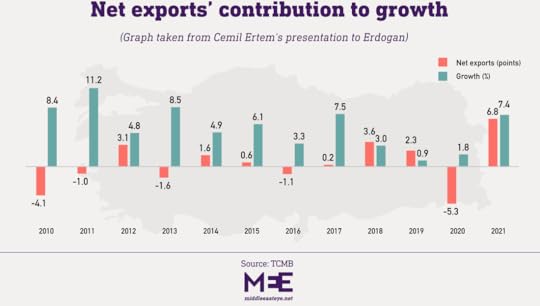
But can this be sustained? If domestic inflation keeps tracks with devaluation then there is no gain in competitiveness.
With import prices soaring, the economic circumstances threaten to crush domestic demand; a recent 50 per cent rise in the minimum wage will wipe out the cost advantages of the currency depreciation, according to Tim Ash of BlueBay Asset Management. “If [Erdogan] had managed to hold [the line] when there were 10 lira to the [US] dollar, maybe they had a chance but, now inflation is out of the bag, the competitive advantage will go out of the window and we are in a devaluation inflation spiral,” Ash said.
Furthermore, for devaluation to yield dramatic benefits would require an industrial policy to back it up. The people that the FT talked to, doubt that Erdogan has any such plan.
In recent months, as Erdogan launched another easing cycle, he has reportedly cited China’s economic transformation in the wake of 1978 reforms as evidence that his model would bear fruit. But Ali Akkemik, an expert on the economies of both China and Turkey at Japan’s Yamaguchi University, said that while it was true that Beijing had devalued its currency in the 1980s and 1990s, it had implemented a clear “industrial vision” that was crucial in its transformation into the world’s second-largest economy over the course of several decades. “Turkey doesn’t have any clearly defined industrial policy,” he warned. “We don’t know what industry they’re trying to promote.” A London-based banker with expertise on both economies who asked not to be named put it more bluntly. “It is economically crazy to think that a country can build an export-oriented economy simply on the back of a trashed currency,” he said. “If that were the case, Zimbabwe would be a tech superpower.”
Nor is the political logic of Erdogan’s maneuvering as obvious as it might seem. As Atilla Yesilada, an analyst at the consultancy GlobalSource Partners, remarked: “this is not a policy that benefits any identifiable constituency, including his family . . . or his cronies”.
Some businesses are gaining from the slide in the currency. “Most of the companies listed on the Borsa Istanbul are benefiting from the weak lira,” said Selim Kunter, an equities analyst at the Istanbul-based Ak Yatirim. He pointed to publicly listed airlines, defence groups, carmakers and chemicals producers as companies that enjoy foreign currency-denominated revenues and Turkish lira-denominated staffing costs. …. “Erdogan is prioritising exporters over households,” said Jason Tuvey of the consultancy Capital Economics. “If you think about his support base, it doesn’t really make sense at all.” Many big exporters have also been critical of the currency volatility, which they say makes it difficult to price their products and plan ahead. Tusiad, a group representing large industrial companies that account for 85 per cent of Turkey’s foreign trade, excluding energy, has warned that what the business world needs most is stability. Musiad, a business association with close links to the ruling party, recently added its voice to the disquiet in a rare critique of the president’s approach. “A businessman needs to know what the exchange rate will be in two to three months’ time and how much it will rise,”
Even the construction sector, the usual beneficiary of AKP largesse has begun to complain. The high cost of raw materials is hurting them.
Erdogan simply “doesn’t have a game plan”, Yesilada said, pointing to the fact that Turkish authorities have spent several billion dollars defending the lira in recent weeks while simultaneously praising the virtues of a cheap currency. “We can discuss it for hours. None of it makes sense,” said Yesilada. “There isn’t any logic.”
***
Over the course of this week there has been a period of stabilization. The exchange rate was oversold. As the IIF’s Robin Brooks insists, the lira was spectacularly undervalued relative to its fair value. Turkey’s hard currency bonds still enjoy considerable market support.
To achieve stabilization, Erdogan’s government has launched an innovative scheme to drive deposits back into lira bank accounts. As the Middle East Eye explains:
Turk Dolar: The new tool, labelled the “Turkish dollar” by some on social media, offers a solution to this problem: if investors convert their foreign currencies into lira and deposit them in a savings account with a certain term of maturity, Turkey’s treasury guarantees that it will get the same return as forex markets. And if the forex markets drop below the official interest rates, the investor will still get an official interest rate return.
The result has been to produce a significant lira rally. But it also risks having perverse effects.
“In effect, all this just increases dollarisation, as the deposit base either is in FX or now FX linked,” Tim Ash, a senior strategist at London-based BlueBay Asset Management, said. “And the public purse picks up the bill. Arguably dollarisation shifts from the private to public sector.”
A similar scheme adopted in the 1970s helped to fuel a disastrous inflation. “Baris Soydan, a prominent Turkish journalist, said in a column on Tuesday that the idea was initially brought back by officials in 2018, but they quickly abandoned it because of possible and deep ramifications on the treasury.”
El Erian in the FT opined that it may buy Ankara some time. But what it will need to do is precisely what Erdogan is not committed to doing i.e. “
The government can help this process by credibly signalling that the latest measures are not an end in themselves but rather a bridge to a more comprehensive set of policies. This would include explicit rate hikes by the central bank which, at this point, are still necessary but no longer sufficient. Turkey will also need to seek other internal anchors, such as a tightening of fiscal policy, and perhaps also external ones, such as agreement on an IMF programme that provides both funding and external validations. All this will need to be done while avoiding the understandable temptation of capital controls that would undermine a historically powerful, and still impactful open growth model that, both economically and financially, exploits Turkey’s many “competitive edges”.”
Rather than beating about the bush, Barry Eichengreen simply concludes that Turkey is now en route to hyperinflation.
Hyperinflation, of course, has two ingredients. First, money creation that fuels inflation. Second, and critically, inflation that fuels money creation. Erdoğan’s deposit guarantee adds this second element. The Turkish Treasury is not going to be able to sell bonds to finance its deposit scheme. It will have to rely on central bank credit … Although there are alternatives to the high-inflation scenario, none is happy.
***
The answer from Erdogan himself?

December 20, 2021
Chartbook #62: Once a giant: the decline of the Bundesbank – Or, who is Joachim Nagel and will it matter?
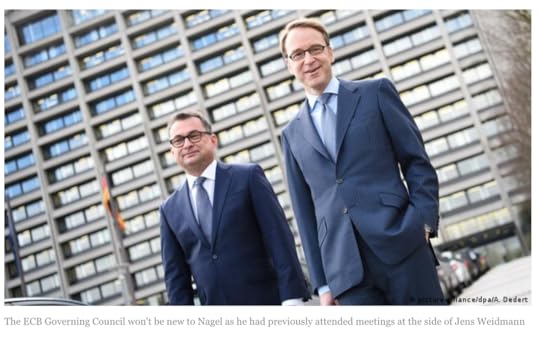
This morning Germany’s Finance Minister Christian Lindner confirmed that he and Chancellor Scholz would be jointly nominating Joachim Nagel to succeed Jens Weidmann as President of the Bundesbank. What does it mean for Germany and Europe’s monetary policy?
In 2019 Weidmann’s ambitions at the ECB were blocked by Lagarde’s appointment. He has had to give ground on policy issues like climate. Perhaps not surprisingly, Weidmann chose not to serve out a full second term as Bundesbank President.
Since his appointment to the Bundesbank following Axel Weber’s abrupt resignation from the frontline of central banking in early 2011, Weidmann made himself into the figurehead of financial conservatism in Europe. He refused to fall into line with the majority on the ECB board and allowed himself to be instrumentalized by Germany’s populist media.
A day after @bild defamed ECB president Mario Draghi as „Count Draghila“ who is sucking the blood out of German savers, @bundesbank governor Jens Weidmann is giving the same paper an interview, implicitly legitimating the rag’s populist claim. Outrageous! (h/t @MichaelMaischHB) pic.twitter.com/a0P1S7WWSo
— Olaf Storbeck (@OlafStorbeck) September 14, 2019
Now, we all want to know, who is Joachim Nagel and how he might differ from Weidmann? But, an even more important question is whether it will matter and if so, how. Or, to put it less facetiously, can Weidmann’s successor organize a more graceful adjustment to the Bundesbank’s new and diminished role within the Eurosystem? If he can, it will remove a major source of tension in European politics and make a substantial contribution to the solidity of Europe’s common currency. Is Nagel the central banker to reconcile German politics to the de facto retreat of the Bundesbank from the top tier of global monetary politics to its role, today, as a subordinate player in the Eurosystem?
***
Once the Bundesbank was a mighty monetary power, a key player at the global level and an icon of West Germany’s miraculous recovery after 1945.
That surprising development is described from the German political angle by the fascinating political and cultural history of the Bundesbank that Simon Mee published with Cambridge University Press in 2019.
As Mee shows, postwar Germany was the site for the construction of a
‘monetary mythology’, a carefully constructed historical narrative about the inter-war period of Germany that flourished in the West German public sphere following the Second World War.24 It explores this myth-making by analysing how the lessons of Germany’s experience of inflation, namely the 1922–3 hyperinflation and 1936–45 inflation, became politicised in the post-war era and transformed into political weapons in support of central bank independence. In the debate surrounding the establishment of West Germany’s central bank, the country’s monetary history became a political football as central bankers, politicians, industrialists and trade unionists all vied for influence over the legal provisions grounding the future monetary authority. The debate centred on power
Bundesbank independence was an effect of domestic political battles. But also, crucially, of international factors.
Within the gold-backed, dollar-based Bretton Woods regime between 1945 and 1973, the remit for national central banks was severely constricted. It is only after the collapse of Bretton Woods that the Bundesbank could emerge as a dominant force in Europe and on the global stage.
As Benjamin Braun shows in a brilliant essay, the Bundesbank’s espousal of monetarism in 1973 helped to shape an entire narrative of money as an exogenous force that had to be tamed by central bank policy.
In 1970s and 1980s the Bundesbank demonstrated its independence by clashing repeatedly with the social-liberal governments headed by Helmut Schmidt. Here is how Inga Rademacher describes the situation in 1979 in a fascinating essay from earlier this year,
That the Bundesbank used the dependence of the Schmidt administration on lower interest rates during the process of bargaining shows how state actors strategically use political and economic conditions for bargaining outcomes (PTE 3). Since Schmidt tried to achieve a simultaneous harmonisation of interest rates across the G7 countries and a domestic fiscal stimulus in 1979 and 1980 (further elaborated on in PTE 4), the administration was particularly vulnerable to higher interest rates. In a cabinet meeting in 1980, Schmidt laid out his plan to harmonise interest rates internationally and urged the Bundesbank to use ‘all available measures to keep international economic relations intact’ (BArch 1980, 5th cabinet meeting). However, the Bundesbank rebutted that it was no longer in control of domestic interest rates as the upward pressures of international interest rates spilled over into the German economy. It was, therefore, of utmost importance that fiscal measures enhanced investor trust in the DM to limit capital flight (BArch, 1979, 126th cabinet meeting; BArch, 1980, 5th cabinet meeting).
To get a sense of how open the clash was at the time, read this report from Die Zeit in 1982 after Schmidt’s loss of the Chancellorship.
But the Bundesbank did not just have influence at the domestic level. It set the terms for interest policy within Europe and beyond. That involved it in a complex bargaining process with Germany’s European neighbors by way of the European Exchange Rate Mechanism. The Bundesbank was suspicious of Bonn’s tendency to make concessions to Paris.
In the late 1980s three shifts ushered in the apotheosis of Bundesbank power. The liberalization of capital movements across Europe from 1988 increased vulnerability to capital flows. In 1988 the Bundesbank began a concerted push to raise interest rates and align them with those of the United States. And in 1990 the end of the Cold War and the process of German unification created further pressure to raise rates. The result was that the Bundesbank delivered a dramatic interest rate shock.
This moment is analyzed in this fascinating article from 2019 by Arie Krampf.
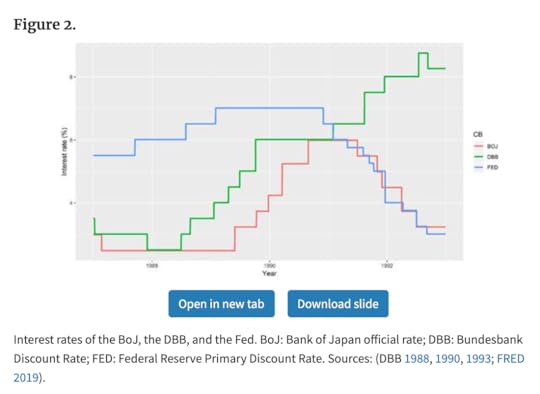
As Krampf summarizes his conclusions:
Bundesbank go-it-alone strategy in 1989 triggered a cross-national sequence of events that changed the international monetary order in a way that was consistent with the German interests. The transition was marked by a shift from the US-led pragmatist approach of international macroeconomic coordination to a rules-based approach founded on the principle of low-inflation–targeting. The article argues that this change took place despite the opposition of the Federal Reserve System (Fed) and the US Treasury.
This truly was the (anti)-heroic period of German monetary power. As the Bundesbank itself sees it, it helped to set in motion the worldwide diffusion of the independent central banking model.
But at the same moment, with the Maastricht Treaty of 1992s, steps were being initiated to curb its independent national power, through submergence in Europe’s common currency.
***
Where is the Bundesbank today?
It retains the nimbus of a major national institution. It stands for monetary solidity. But as no lesser authorities than Martin Hellwig and Isabel Schnabel reminded the Bundestag in 2019.
The fiction of the (national, AT) “we” elides the fact that the Bundesbank in its operative business is no longer a German institution, but a part of the supranational Eurosystem.
It is that awkward hybrid status that the President of the Bundesbank has to navigate.
Whilst the ECB could be presented as essentially continuing the Bundesbank’s heritage, it generated relatively little tension. But since 2008 that has no longer been the case.
The Bundesbank has been exposed as a somewhat lonely institution.
It is famously independent. But its President and Vice-President are simply appointed by the German government. Jens Weidmann’s main qualification for the job in 2011 was that he had been Angela Merkel’s economic and financial advisor.
There is no elaborate confirmation process as in the US. The other half of the board members by the Federal Council. They represent regional interests. And whereas other central banks have moved to a model of transparency and accountability, the Bundesbank lags behind.
Unlike the Fed, the Bundesbank doesn’t hold regular hearings with the Bundestag. One of the innovations prompted by the 2020 ruling by the German constitutional court on the legality of the ECB’s bond purchase programs was a hearing at which Weidmann laid out the monetary policy of the ECB for the Finance Committee of the Bundestag.
Of course the glory days of its first half century provide the Bundesbank with a nimbus. But it was rather peculiar circumstances that gave Weidmann his prominence.
First and foremost there was the eurozone crisis. This raised the stakes and gave Germany a veto of financial policy, though not over decisions at the ECB. Weidmann’s personal closeness to Merkel was important. As was the fact that circumstances and Merkel’s personal proclivities demanded a gradual adjustment of the conservative model of monetary and fiscal policy to realities in the Eurozone. This opened up a space for German conservatives to pose as the rearguard, defending the lost cause of the old Federal Republic. The AfD was the populist wing of this movement. Weidmann was its respectable face. This was a choice. As Schnabel has shown at the ECB, German central bankers can also choose to make themselves part of the process by which rules and institutions are adjusted to new realities.
In Weidmann’s defense, you could say that his rearguard action was important in giving voice to the pain of German conservatives, indignant at the situation they found themselves in and at the compromises that Merkel was making.
But the result was to encouraged the alienation between a certain segment of the German public and the ECB. As recent opinion polls have found there is a substantial gap between the share of the German public who trust the Bundesbank and the ECB, with a substantial minority expressing little or no trust in the ECB, whilst continuing to trust the Bundesbank.
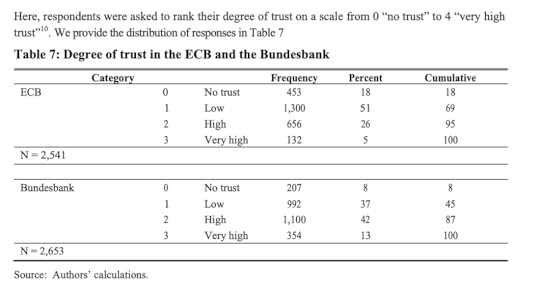
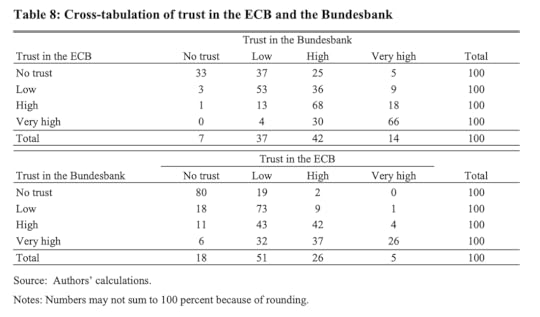
Source: Mellina and Schmidt 2018
Though this is alarming, it should also be said that overall levels of mistrust towards the ECB are lower in Germany than in any other large economy in the Eurozone.
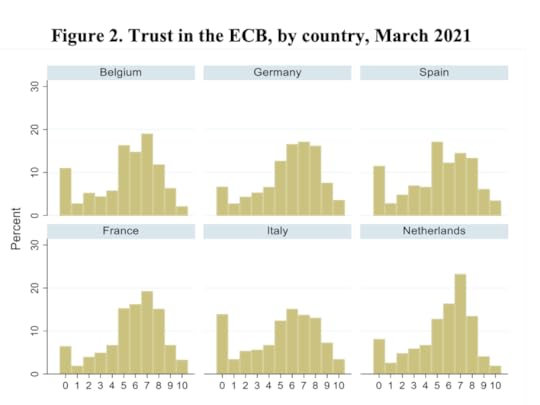
Source: Van der Cruijsen, Carin, and Anna Samarina. Trust in the ECB in turbulent times. DeNederlandsche Bank Working Paper 722, 2021.
There can be little doubt that what Olaf Scholz will be looking for in a Bundesbank boss, is not a conservative tribune of the Weidmann type, but someone who can continue to close the gap between German confidence in their national institutions and the authority of the ECB.
Schnabel was performing that role to a high degree at the ECB. Moving her to the Bundesbank would have been a demotion and would have posed the question of how to find an adequate replacement at the ECB. Joachim Nagel may be the man for the job.
***
The bios of Nagel rehearse the same lines, but in some sense miss the obvious. He’s a West German success story.

(He also seems to be a natty dresser. Nice outfit for riding a new Indian subway line!)
Nagel was born 1966 in Karlsruhe and, strikingly, he also chose to study there. The Karlsruhe TH is a renowned institution, but for Germany at the time this was an unusually conservative choice. There is little I can find on Nagel’s family background, but constrained family circumstances would be one explanation.
In the early 1990s, he won a coveted gig as an assistant and reseacher (Wissenschaftlicher Mitarbeiter) at the University.
In March-October 1994 during Rudolf Scharping’s failed bid to unseat Helmut Kohl, Nagel took time out to join the SPD economics team. The party at the time was rocked by bitter arguments between left and right wings.
Nagel chose not to stay in politics. Instead, in 1997 at the ripe age of 31 he took his PhD from Karlsruhe with a PhD on the supply-sideconomic policy of Ronald Reagan.
Having skimmed the PhD two things stand out. It is not a highly technical exercise, more a narrative treatment of the 1980s economic policy scene in the US. He concludes that the Reagan administration was not successful in dramatically lowering marginal tax rates (state-level increase offset federal cuts). But, rather than rejecting supply side measures outright, in conclusion Nagel pleads for a reconciliation between demand-side macroeconomic policy and supply-side policy. Above all he calls for a coordination of policy.
After this rather undistinguished start, in 1998 he headed to Washington DC to do a year of research. Again this was enabled by local support, in this case the SEW-Eurodrive Stiftung, a Baden-Württemberg corporate foundation.
Nagel’s career began to accelerate when he returned to join the Bundesbank in 1998. Nagel spent his first few years at the Hanover Regional Office before transferring to the Bundesbank’s Central Office in Frankfurt am Main in 2003.
At the Bundesbank Nagel was a protege of Hans-Helmut Kotz, also of the SPD.
In 2008 he was appointed Director General Markets. (Some timing, AT)
In December 2010, at the precocious age of 44, with the backing of Kotz, Nagel was promoted to the Bundesbank’s Executive Board, where his responsibilities encompassed the Directorates General Markets and Information Technology. This is a big career leap. He replaced the right-wing SPD man Thilo Sarrazin, who will later become notorious for his views on immigration.
In this role Nagel represented the Bundesbank in international negotiations and until the end of April 2016 headed the bank’s crisis-management team.
In the BIS database of central bank speeches, Nagel has a limited presence. He Speaks most often about renminbi internationalization and seems to have been focused above all on markets.
In 2013 Nagel gave a joint interview with Benoit Coueré which suggests that he kept his cool during the taper tantrum. He does not come across as heady like Coueré, but he holds his own.
“Question: Some people argue that the ECB should not worry about risks and losses because central banks can operate with negative capital.
Nagel: There is a general understanding that central banks can function with negative capital. But the Bundesbank believes that this would be a dire signal.
Cœuré: This is exactly the right answer. Technically and legally it would be possible for the ECB to run with negative capital, but it would undermine the confidence in the ECB and the trust in the euro and therefore it should not happen.”
Nagel is widely seen as an “ordoliberal”, whatever that means. In German media that may just be code for “he is one of us”.
In 2015, as the FT reports, he gave an interview to the Börsenzeitung in which he expressed reservations about Draghi’s new QE program.
Shortly after the ECB started its quantitative easing policy of buying vast amounts of government bonds in 2015, Nagel warned in an interview with German newspaper, Börsen-Zeitung, of the “key danger” of an “intermingling of monetary policy and fiscal policy”. Echoing concerns often expressed by Weidmann during his decade at the helm of the Bundesbank, Nagel said: “There is a risk that the budgetary consolidation required in some euro countries will be put on the backburner”, which he said “could then increase political pressure on the ECB council to postpone an interest rate hike that is necessary from a monetary policy point of view”.
At his farewell from the Bundesbank in 2016, Weidmann stressed Nagel’s
“decisiveness, ability to communicate, detailed knowledge of the financial markets and analytical skills. He also reminded the audience of Nagel’s key role in bringing a renminbi clearing hub to Frankfurt am Main.”
Why did Nagel leave the Bundesbank in 2016?
According to German sources it was down to politics. In 2014 the SPD wanted Nagel to get the deputy position at the Bundesbank, but they were in a weak position. The CDU preferred Claudia Buch. Realizing that the wind was not blowing in his favor Nagel jumped.
Clearly, the idea of the Bundesbank as an independent institution does not mean that party cards do not play a major role in top careers!
After leaving the Bundesbank in 2016, Nagel joined the executive board of KfW, the German state-owned development and investment bank.
At the KfW 2017-2020, he was responsible for promoting developing and emerging countries. At the same time he was chairman of the supervisory board of KfW Ipex-Bank.
“Here comes the less pleasant episode.” According to one muckraking website:
“As part of a banking consortium, KfW Ipex-Bank granted the payment service provider Wirecard a loan of more than 100 million euros in September 2018 and extended it in mid-2019. At this point in time, however, the problems at Wirecard were no longer a secret. The lending falls during Nagel’s tenure as chairman of the bank’s board of directors. Wirecard went bankrupt in 2020. At Ipex-Bank, searches of the police and the public prosecutor’s office took place in the same year because of the initial suspicion of infidelity. Ipex-Bank ended up having to write off 90 percent of the money. Now it will become clear to what extent his mandate at KfW could be dangerous for Nagel if he soon took on a top position at the Bundesbank.”
Not recognizing the risk posed by Wirecard is a failure that Scholz and his team have in common.
At the KFW, Nagel found himself in a leadership position in one of key, public promotional banks, which is widely cited as a model for climate finance. To judge by his KfW web-presentation, Nagel may be greener than Weidmann.
“Many young people in particular are demanding greater climate action today; they do not think the measures taken against global warming to date have been adequate. What would you say to them? Where do we stand four years after the passage of the Paris Agreement?
Dr Joachim Nagel: The international climate agreement is still intact, despite scepticism in some capital cities, particularly in Washington. What’s more: we are seeing a growing commitment to climate change mitigation in all areas of the world, for example in countries like Costa Rica, Colombia, Morocco or Ethiopia, all countries that have set ambitious climate goals. The issue is currently experiencing welcome momentum. Still, we need to accelerate our efforts considerably. We ultimately need to sustainably change the global economy. We cannot and must not leave the brunt of climate change mitigation to the next generation.
Does this acceleration also apply to KfW?
Nagel: Definitely. We will further expand our commitment domestically and abroad.”
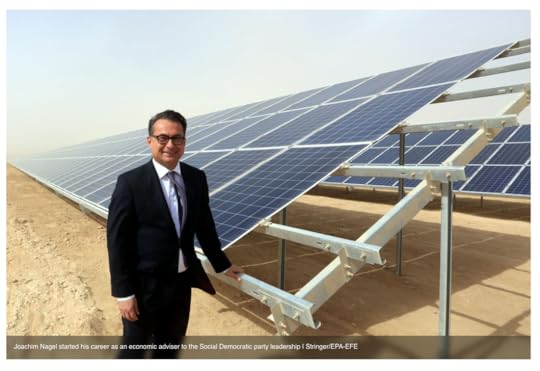
All in all everything suggests that this non-dogmatic, SPD-aligned veteran of 2008 will play nicely with Lagarde and his European colleagues.
It was telling that the FT wrapped up its report with a quote from Karsten Junius, chief economist at Bank J Safra Sarasin.
He said he hoped Nagel’s appointment would allow the Bundesbank “to criticise the monetary policy of the ECB less from the edge, but rather help shape it and explain it better in Germany”.
Likewise in Politico:
“He would signal a degree of Bundesbank continuity, coupled with market and international experience,” said Berenberg economist Holger Schmieding. “He could turn into a bridge between the ECB and the German public, shaping ECB decisions while helping to explain them to the German public.”
This is, indeed, what the Scholz administration and Europe need from the Bundesbank, a post-heroic accommodation with the dramatic change and a willingness to put Germany’s weight behind the irreversible project of monetary (and eventually financial) unification.
***
I love putting out Chartbook for free to a wide and diverse range of subscribers from all over the world. It is a pleasure to write and a great place to pull ideas together. It is also, however, a lot of work. If you feel moved to support the project, there are three subscription options:
The annual subscription: $50 annuallyThe standard monthly subscription: $5 monthly – which gives you a bit more flexibility.Founders club:$ 120 annually, or another amount at your discretion – for those who really love Chartbook Newsletter, or read it in a professional setting in which you regularly pay for subscriptions, please consider signing up for the Founders Club.December 19, 2021
Chartbook #61: Update – RIP a climate revolution in fiscal policy?
It seems that history was burying the climate revolution in fiscal policy just as I was diagnosing it.
Literally as I was doing the final edits on Chartbook #61 this morning, Joe Manchin was on Fox TV, announcing that he would not vote for the Build Back Bill.
Clearly the talks were tough. But I hadn’t heard rumors that he was about to do this. Gut punch.
Here is the FT view.
Along with everyone else, I’m reeling.
Manchin’s position is rooted in West Virginia circumstances (see Chartbook 46)
Back in November, folks close to the process felt confident of Manchin’s vote after all the concessions that he had extracted.
Counting on his vote was key to getting the Democratic Party Left to support the inadequate bipartisan infrastructure bill.
Inflation may have provided Manchin with the excuse he needed to shift position.
The New Statesman piece highlights the inflation issue and offers a fairly grim assessment.
But if this really is it, it is disastrous for the Biden admin. A truly brutal denouement.
Credit to Mark Blyth. He was calling this on a conference call a few weeks back.
The assessment of the policy process as such, still stands. It may still be worth thinking about the world we seem to be losing.
For now, all bets are off.
Apologies to readers for the poor timing.
Adam Tooze's Blog
- Adam Tooze's profile
- 767 followers






